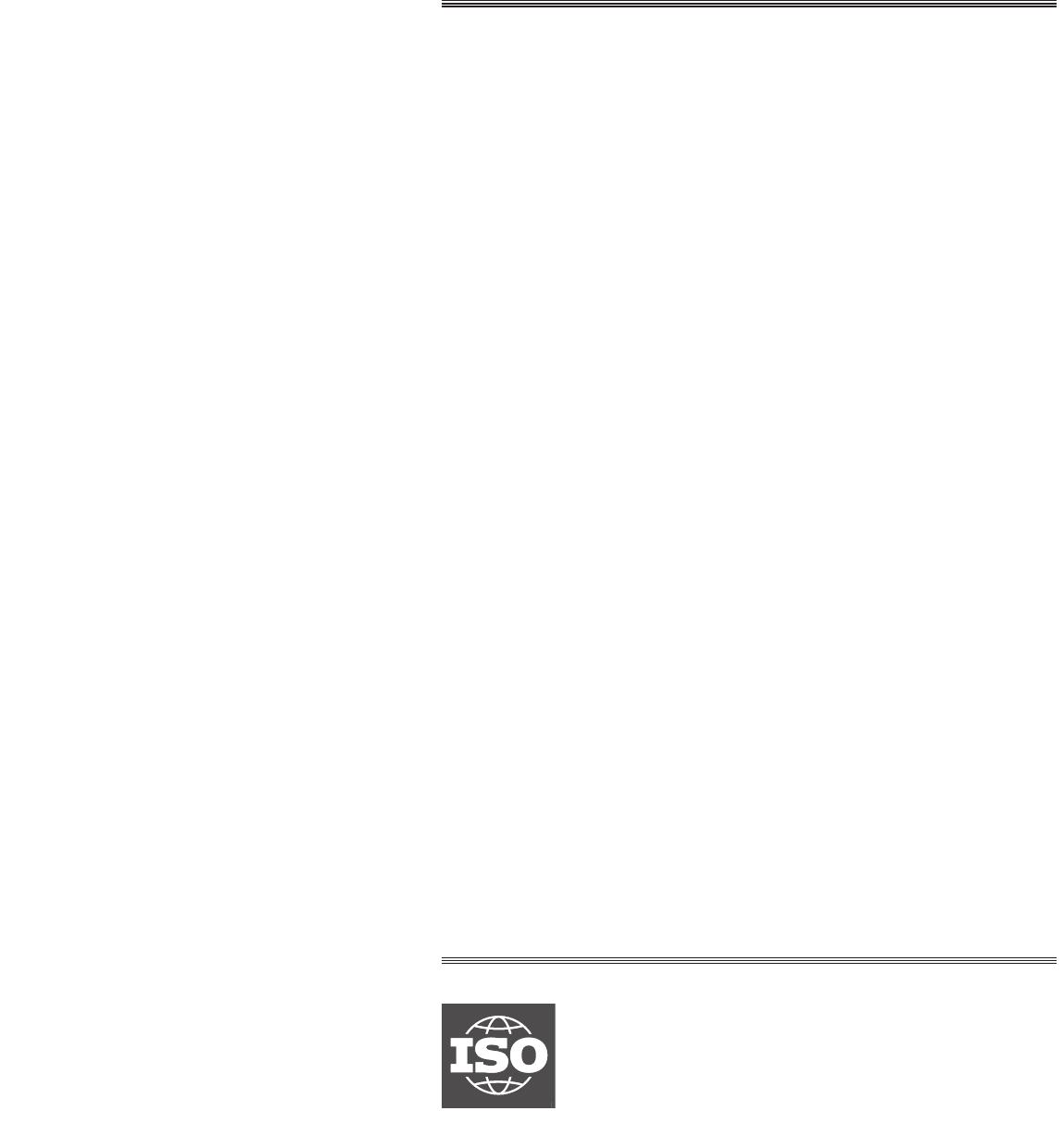©ISO2018Greenhousegases—Carbonfootprintofproducts—RequirementsandguidelinesforquantificationGazàeffetdeserre—Empreintecarbonedesproduits—ExigencesetlignesdirectricespourlaquantificationINTERNATIONALSTANDARDISO14067Firstedition2018-08ReferencenumberISO14067:2018(E)CopyrightInternationalOrganizationforStandardization--`,,,``,`,``,,,```,``,```,,``-`-`,,`,,`,`,,`---ISO14067:2018(E)ii�©ISO2018–AllrightsreservedCOPYRIGHTPROTECTEDDOCUMENT©ISO2018Allrightsreserved.Unlessotherwisespecified,orrequiredinthecontextofitsimplementation,nopartofthispublicationmaybereproducedorutilizedotherwiseinanyformorbyanymeans,electronicormechanical,includingphotocopying,orpostingontheinternetoranintranet,withoutpriorwrittenpermission.PermissioncanberequestedfromeitherISOattheaddressbeloworISO’smemberbodyinthecountryoftherequester.ISOcopyrightofficeCP401•Ch.deBlandonnet8CH-1214Vernier,GenevaPhone:+41227490111Fax:+41227490947Email:copyright@iso.orgWebsite:www.iso.orgPublishedinSwitzerlandCopyrightInternationalOrganizationforStandardization--`,,,``,`,``,,,```,``,```,,``-`-`,,`,,`,`,,`---ISO14067:2018(E)Foreword...........................................................................................................................................................................................................................................vIntroduction.................................................................................................................................................................................................................................vi1Scope..................................................................................................................................................................................................................................12Normativereferences.......................................................................................................................................................................................13Terms,definitionsandabbreviatedterms.................................................................................................................................13.1Termsanddefinitions........................................................................................................................................................................13.1.1Quantificationofthecarbonfootprintofaproduct...........................................................................23.1.2Greenhousegases.............................................................................................................................................................43.1.3Products,productsystemsandprocesses..................................................................................................53.1.4Lifecycleassessment....................................................................................................................................................73.1.5Organizations.......................................................................................................................................................................83.1.6Dataanddataquality....................................................................................................................................................93.1.7Biogenicmaterialandlanduse.........................................................................................................................103.2Abbreviatedterms.............................................................................................................................................................................114Application...............................................................................................................................................................................................................115Principles...................................................................................................................................................................................................................115.1General.........................................................................................................................................................................................................115.2Lifecycleperspective......................................................................................................................................................................115.3Relativeapproachandfunctionalordeclaredunit...............................................................................................125.4Iterativeapproach..............................................................................................................................................................................125.5Priorityofscientificapproach.................................................................................................................................................125.6Relevance...................................................................................................................................................................................................125.7Completeness.........................................................................................................................................................................................125.8Consistency..............................................................................................................................................................................................125.9Coherence..................................................................................................................................................................................................125.10Accuracy......................................................................................................................................................................................................125.11Transparency..........................................................................................................................................................................................135.12Avoidanceofdouble-counting.................................................................................................................................................136MethodologyforquantificationoftheCFPandpartialCFP..................................................................................136.1General.........................................................................................................................................................................................................136.2UseofCFP–PCR.....................................................................................................................................................................................136.3Goalandscopedefinition............................................................................................................................................................146.3.1GoalofaCFPstudy.......................................................................................................................................................146.3.2ScopeofaCFPstudy...................................................................................................................................................146.3.3Functionalordeclaredunit..................................................................................................................................156.3.4Systemboundary...........................................................................................................................................................156.3.5Dataanddataquality.................................................................................................................................................166.3.6Timeboundaryfordata...........................................................................................................................................176.3.7Usestageanduseprofile........................................................................................................................................186.3.8End-of-lifestage..............................................................................................................................................................186.4LifecycleinventoryanalysisfortheCFP........................................................................................................................196.4.1General...................................................................................................................................................................................196.4.2Datacollection.................................................................................................................................................................206.4.3Validationofdata...........................................................................................................................................................206.4.4Relatingdatatounitprocessandfunctionalordeclaredunit...............................................206.4.5Refiningthesystemboundary...........................................................................................................................206.4.6Allocation.............................................................................................................................................................................216.4.7CFPperformancetracking.....................................................................................................................................226.4.8AssessingtheeffectofthetimingofGHGemissionsandremovals...................................236.4.9TreatmentofspecificGHGemissionsandremovals.......................................................................236.5ImpactassessmentforCFPorpartialCFP....................................................................................................................296.5.1General...................................................................................................................................................................................29©ISO2018–Allrightsreserved�iiiContents�PageCopyrightInternationalOrganizationforStandardization--`,,,``,`,``,,,```,``,```,,``-`-`,,`,,`,`,,`---ISO14067:2018(E)6.5.2Impactassessmentofbiogeniccarbon.......................................................................................................296.6InterpretationofCFPorpartialCFP..................................................................................................................................297CFPstudyreport.................................................................................................................................................................................................307.1General.........................................................................................................................................................................................................307.2GHGvaluesintheCFPstudyreport....................................................................................................................................307.3RequiredinformationfortheCFPstudyreport.......................................................................................................317.4OptionalinformationfortheCFPstudyreport.........................................................................................................328Criticalreview.......................................................................................................................................................................................................32AnnexA(normative)LimitationsoftheCFP..............................................................................................................................................33AnnexB(normative)ComparisonbasedontheCFPofdifferentproducts...............................................................35AnnexC(normative)TheCFPsystematicapproach..........................................................................................................................36AnnexD(informative)PossibleproceduresforthetreatmentofrecyclinginCFPstudies......................38AnnexE(informative)GuidanceonquantifyingGHGemissionsandremovalsforagriculturalandforestryproducts..................................................................................................................................................42Bibliography..............................................................................................................................................................................................................................45iv�©ISO2018–AllrightsreservedCopyrightInternationalOrganizationforStandardization--`,,,``,`,``,,,```,``,```,,``-`-`,,`,,`,`,,`---ISO14067:2018(E)ForewordISO(theInternationalOrganizationforStandardization)isaworldwidefederationofnationalstandardsbodies(ISOmemberbodies).TheworkofpreparingInternationalStandardsisnormallycarriedoutthroughISOtechnicalcommittees.Eachmemberbodyinterestedinasubjectforwhichatechnicalcommitteehasbeenestablishedhastherighttoberepresentedonthatcommittee.Internationalorganizations,governmentalandnon-governmental,inliaisonwithISO,alsotakepartinthework.ISOcollaboratescloselywiththeInternationalElectrotechnicalCommission(IEC)onallmattersofelectrotechnicalstandardization.TheproceduresusedtodevelopthisdocumentandthoseintendedforitsfurthermaintenancearedescribedintheISO/IECDirectives,Part1.Inparticular,thedifferentapprovalcriterianeededforthedifferenttypesofISOdocumentsshouldbenoted.ThisdocumentwasdraftedinaccordancewiththeeditorialrulesoftheISO/IECDirectives,Part2(seewww.iso.org/directives).Attentionisdrawntothepossibilitythatsomeoftheelementsofthisdocumentmaybethesubjectofpatentrights.ISOshallnotbeheldresponsibleforidentifyinganyorallsuchpatentrights.DetailsofanypatentrightsidentifiedduringthedevelopmentofthedocumentwillbeintheIntroductionand/orontheISOlistofpatentdeclarationsreceived(seewww.iso.org/patents).Anytradenameusedinthisdocumentisinformationgivenfortheconvenienceofusersanddoesnotconstituteanendorsement.Foranexplanationofthevoluntarynatureofstandards,themeaningofISOspecifictermsandexpressionsrelatedtoconformityassessment,aswellasinformationaboutISO’sadherencetotheWorldTradeOrganization(WTO)principlesintheTechnicalBarrierstoTrade(TBT)seewww.iso.org/iso/foreword.html.ThisdocumentwaspreparedbyTechnicalCommitteeISO/TC207,Environmentalmanagement,SubcommitteeSC7,Greenhousegasmanagementandrelatedactivities.ThisfirsteditioncancelsandreplacesISO/TS14067:2013,whichhasbeentechnicallyrevised.Itconstitutesareductioninscopeasfollows:—principles,requirementsandguidanceoncommunicationofthecarbonfootprintofaproduct(CFP)andthepartialCFParenowcoveredinISO14026;—principles,requirementsandguidanceonverificationarenowcoveredinISO14064-3;—principles,requirementsandguidanceonPCRarenowcoveredinISO/TS14027;—requirementsforthetreatmentofbiogeniccarbonandelectricityhavebeenrevisedandclarified;—thedefinitionshavebeenalignedwithintheISO14064seriesforeaseofinterpretation.Thisdocumentisthegenericstandardforthequantificationofthecarbonfootprintofproducts.Anyfeedbackorquestionsonthisdocumentshouldbedirectedtotheuser’snationalstandardsbody.Acompletelistingofthesebodiescanbefoundatwww.iso.org/members.html.©ISO2018–Allrightsreserved�vCopyrightInternationalOrganizationforStandardization--`,,,``,`,``,,,```,``,```,,``-`-`,,`,,`,`,,`---ISO14067:2018(E)IntroductionClimatechangearisingfromanthropogenicactivityhasbeenidentifiedasoneofthegreatestchallengesfacingtheworldandwillcontinuetoaffectbusinessandcitizensoverfuturedecades.Climatechangehasimplicationsforbothhumanandnaturalsystemsandcouldleadtosignificantimpactsonresourceavailability,economicactivityandhumanwellbeing.Inresponse,international,regional,nationalandlocalinitiativesarebeingdevelopedandimplementedbypublicandprivatesectorstomitigategreenhousegas(GHG)concentrationsintheEarth’satmosphereaswellastofacilitateadaptationtoclimatechange.Thereisaneedforaneffectiveandprogressiveresponsetotheurgentthreatofclimatechangeonthebasisofthebestavailablescientificknowledge.ISOproducesdocumentsthatsupportthetransformationofscientificknowledgeintotoolsthatwillhelpaddressclimatechange.GHGinitiativesonmitigationrelyonthequantification,monitoring,reportingandverificationofGHGemissionsand/orremovals.TheISO14060familyprovidesclarityandconsistencyforquantifying,monitoring,reportingandvalidatingorverifyingGHGemissionsandremovalstosupportsustainabledevelopmentthroughalow-carboneconomy.Italsobenefitsorganizations,projectproponentsandstakeholdersworldwidebyprovidingclarityandconsistencyonquantifying,monitoring,reporting,andvalidatingorverifyingGHGemissionsandremovals.Specifically,theuseoftheISO14060family:—enhancestheenvironmentalintegrityofGHGquantification;—enhancesthecredibility,consistency,andtransparencyofGHGquantification,monitoring,reporting,validationandverification;—facilitatesthedevelopmentandimplementationofGHGmanagementstrategiesandplans;—facilitatesthedevelopmentandimplementationofmitigationactionsthroughemissionreductionsorremovalenhancements;—facilitatestheabilitytotrackperformanceandprogressinthereductionofGHGemissionsand/orincreaseinGHGremovals.ApplicationsoftheISO14060familyinclude:—corporatedecisions,suchasidentifyingGHGemissionreductionopportunitiesandincreasingprofitabilitybyreducingenergyconsumption;—carbonriskmanagement,suchastheidentificationandmanagementofrisksandopportunities;—voluntaryinitiatives,suchasparticipationinvoluntaryGHGregistriesorsustainabilityreportinginitiatives;—GHGmarkets,suchasthebuyingandsellingofGHGallowancesorcredits;—regulatory/governmentGHGprogrammes,suchascreditforearlyaction,agreementsornationalandlocalreportinginitiatives.ISO14064-1detailsprinciplesandrequirementsfordesigning,developing,managingandreportingorganization-levelGHGinventories.ItincludesrequirementsfordeterminingGHGemissionandremovalboundaries,quantifyinganorganization’sGHGemissionsandremovals,andidentifyingspecificcompanyactionsoractivitiesaimedatimprovingGHGmanagement.Italsoincludesrequirementsandguidanceoninventoryqualitymanagement,reporting,internalauditingandtheorganization’sresponsibilitiesinverificationactivities.vi�©ISO2018–AllrightsreservedCopyrightInternationalOrganizationforStandardization--`,,,``,`,``,,,```,``,```,,``-`-`,,`,,`,`,,`---ISO14067:2018(E)ISO14064-2detailsprinciplesandrequirementsfordeterminingbaselinesandforthemonitoring,quantifyingandreportingofprojectemissions.ItfocusesonGHGprojectsorproject-basedactivitiesspecificallydesignedtoreduceGHGemissionsand/orenhanceGHGremovals.ItprovidesthebasisforGHGprojectstobevalidatedandverified.ISO14064-3detailsrequirementsforverifyingGHGstatementsrelatedtoGHGinventories,GHGprojects,andcarbonfootprintsofproducts.Itdescribestheprocessforvalidationorverification,includingvalidationorverificationplanning,assessmentprocedures,andtheevaluationoforganizational,projectandproductGHGstatements.ISO14065definesrequirementsforbodiesthatvalidateandverifyGHGstatements.Itsrequirementscoverimpartiality,competence,communication,validationandverificationprocesses,appeals,complaints,andthemanagementsystemofvalidationandverificationbodies.Itcanbeusedasabasisforaccreditationandotherformsofrecognitioninrelationtotheimpartiality,competence,andconsistencyofvalidationandverificationbodies.ISO14066specifiescompetencerequirementsforvalidationteamsandverificationteams.Itincludesprinciplesandspecifiescompetencerequirementsbasedonthetasksthatvalidationteamsorverificationteamsmustbeabletoperform.Thisdocumentdefinestheprinciples,requirementsandguidelinesforthequantificationofthecarbonfootprintofproducts.TheaimofthisdocumentistoquantifyGHGemissionsassociatedwiththelifecyclestagesofaproduct,beginningwithresourceextractionandrawmaterialsourcingandextendingthroughtheproduction,useandend-of-lifestagesoftheproduct.ISO/TR14069assistsusersintheapplicationofISO14064-1,providingguidelinesandexamplesforimprovingtransparencyinthequantificationofemissionsandtheirreporting.ItdoesnotprovideadditionalguidancetoISO14064-1.Figure1illustratestherelationshipamongtheISO14060familyofGHGstandards.Figure1—RelationshipamongtheISO14060familyofGHGstandards©ISO2018–Allrightsreserved�viiCopyrightInternationalOrganizationforStandardization--`,,,``,`,``,,,```,``,```,,``-`-`,,`,,`,`,,`---ISO14067:2018(E)NOTEInthisdocument,GHGstatementsaretheCFPorthepartialCFP.GHGscanbeemittedandremovedthroughoutthelifecycleofaproductwhichincludesacquisitionofrawmaterial,design,production,transportation/delivery,useandtheend-of-lifetreatment.Quantificationofthecarbonfootprintofaproduct(CFP)willassistintheunderstandingandactiontoincreaseGHGremovalsandreduceGHGemissionsthroughoutthelifecycleofaproduct.Thisdocumentdetailsprinciples,requirementsandguidelinesforthequantificationofCFPs,i.e.goodsandservices,basedonGHGemissionsandremovalsovertheirlifecycle.RequirementsandguidelinesforthequantificationofapartialCFParealsoprovided.CommunicationrelatedtotheCFPorthepartialCFPiscoveredinISO14026.Thedevelopmentofproductcategoryrules(PCR)iscoveredinISO/TS14027.Thisdocumentisbasedonprinciples,requirementsandguidelinesidentifiedinexistingInternationalStandardsonlifecycleassessment(LCA),ISO14040andISO14044,andaimstosetspecificrequirementsforthequantificationofaCFPandapartialCFP.Thisdocumentisexpectedtobenefitorganizations,governments,industry,serviceproviders,communitiesandotherinterestedpartiesbyprovidingclarityandconsistencyinquantifyingCFPs.Specifically,usingLCAinaccordancewiththisdocument,withclimatechangeasthesingleimpactcategory,canofferbenefitsthrough:—avoidingburden-shiftingfromonestageofaproductlifecycletoanotherorbetweenproductlifecycles;—providingrequirementsforthequantificationoftheCFP;—facilitatingCFPperformancetrackinginreducingGHGemissions;—providingabetterunderstandingoftheCFPsuchthatpotentialopportunitiesforincreasesinGHGremovalsandreductionsofGHGemissionsmightbeidentified;—helpingtopromoteasustainablelowcarboneconomy;—enhancingthecredibility,consistencyandtransparencyofthequantificationandreportingoftheCFP;—facilitatingtheevaluationofalternativeproductdesignandsourcingoptions,productionandmanufacturingmethods,rawmaterialchoices,transportation,recyclingandotherend-of-lifeprocesses;—facilitatingthedevelopmentandimplementationofGHGmanagementstrategiesandplansacrossproductlifecycles,aswellasthedetectionofadditionalefficienciesinthesupplychain;—preparingreliableCFPinformation.NOTEInrespecttotheterminologyofISO14026regardingfootprintcommunication,climatechangeisconsideredasanexampleofan“areaofconcern”.Figure2illustratestheconnectionbetweenthisdocumentandstandardsoutsidetheGHGmanagementfamilyofstandards.viii�©ISO2018–AllrightsreservedCopyrightInternationalOrganizationforStandardization--`,,,``,`,``,,,```,``,```,,``-`-`,,`,,`,`,,`---ISO14067:2018(E)Figure2—RelationshipbetweenthisdocumentandstandardsbeyondtheGHGmanagementfamilyofstandardsCFPspreparedinaccordancewiththisdocumentcontributetotheobjectivesofGHG-relatedpoliciesand/orregimes.LimitationsofCFPsbasedonthisdocumentaredescribedinAnnexA.©ISO2018–Allrightsreserved�ixCopyrightInternationalOrganizationforStandardization--`,,,``,`,``,,,```,``,```,,``-`-`,,`,,`,`,,`---CopyrightInternationalOrganizationforStandardization--`,,,``,`,``,,,```,``,```,,``-`-`,,`,,`,`,,`---Greenhousegases—Carbonfootprintofproducts—Requirementsandguidelinesforquantification1ScopeThisdocumentspecifiesprinciples,requirementsandguidelinesforthequantificationandreportingofthecarbonfootprintofaproduct(CFP),inamannerconsistentwithInternationalStandardsonlifecycleassessment(LCA)(ISO14040andISO14044).RequirementsandguidelinesforthequantificationofapartialCFParealsospecified.ThisdocumentisapplicabletoCFPstudies,theresultsofwhichprovidethebasisfordifferentapplications(seeClause4).Thisdocumentaddressesonlyasingleimpactcategory:climatechange.CarbonoffsettingandcommunicationofCFPorpartialCFPinformationareoutsidethescopeofthisdocument.Thisdocumentdoesnotassessanysocialoreconomicaspectsorimpacts,oranyotherenvironmentalaspectsandrelatedimpactspotentiallyarisingfromthelifecycleofaproduct.2NormativereferencesThefollowingdocumentsarereferredtointhetextinsuchawaythatsomeoralloftheircontentconstitutesrequirementsofthisdocument.Fordatedreferences,onlytheeditioncitedapplies.Forundatedreferences,thelatesteditionofthereferenceddocument(includinganyamendments)applies.ISO/TS14027:2017,Environmentallabelsanddeclarations—DevelopmentofproductcategoryrulesISO14044:2006,Environmentalmanagement—Lifecycleassessment—RequirementsandguidelinesISO/TS14071,Environmentalmanagement—Lifecycleassessment—Criticalreviewprocessesandreviewercompetencies:AdditionalrequirementsandguidelinestoISO14044:20063Terms,definitionsandabbreviatedterms3.1TermsanddefinitionsForthepurposesofthisdocument,thefollowingtermsanddefinitionsapply.ISOandIECmaintainterminologicaldatabasesforuseinstandardizationatthefollowingaddresses:—ISOOnlinebrowsingplatform:availableathttps://www.iso.org/obp—IECElectropedia:availableathttp://www.electropedia.org/INTERNATIONALSTANDARD�ISO14067:2018(E)©ISO2018–Allrightsreserved�1CopyrightInternationalOrganizationforStandardization--`,,,``,`,``,,,```,``,```,,``-`-`,,`,,`,`,,`---ISO14067:2018(E)3.1.1Quantificationofthecarbonfootprintofaproduct3.1.1.1carbonfootprintofaproductCFPsumofGHGemissions(3.1.2.5)andGHGremovals(3.1.2.6)inaproductsystem(3.1.3.2),expressedasCO2equivalents(3.1.2.2)andbasedonalifecycleassessment(3.1.4.3)usingthesingleimpactcategory(3.1.4.8)ofclimatechangeNote1toentry:ACFPcanbedisaggregatedintoasetoffiguresidentifyingspecificGHGemissionsandremovals(seeTable1).ACFPcanalsobedisaggregatedintothestagesofthelifecycle(3.1.4.2).Note2toentry:TheresultsofthequantificationoftheCFParedocumentedintheCFPstudyreport(3.1.1.5)expressedinmassofCO2eperfunctionalunit(3.1.3.7).3.1.1.2partialcarbonfootprintofaproductpartialCFPsumofGHGemissions(3.1.2.5)andGHGremovals(3.1.2.6)ofoneormoreselectedprocess(es)(3.1.3.5)inaproductsystem(3.1.3.2),expressedasCO2equivalents(3.1.2.2)andbasedontheselectedstagesorprocesseswithinthelifecycle(3.1.4.2)Note1toentry:ApartialCFPisbasedonorcompiledfromdatarelatedto(a)specificprocess(es)orfootprintinformationmodules,whichis(are)partofaproductsystemandcanformthebasisforquantificationofaCFP.MoredetailedinformationoninformationmodulesisgiveninISO14025:2006,5.4.Note2toentry:“Footprintinformationmodules”isdefinedinISO14026:2017,3.1.4.Note3toentry:TheresultsofthequantificationofthepartialCFParedocumentedintheCFPstudyreport(3.1.3.5)expressedinmassofCO2eperdeclaredunit(3.1.3.8).3.1.1.3carbonfootprintofaproductsystematicapproachCFPsystematicapproachsetofprocedurestofacilitatethequantificationoftheCFP(3.1.1.6)fortwoormoreproducts(3.1.3.1)ofthesameorganization(3.1.5.1)3.1.1.4carbonfootprintofaproductstudyCFPstudyallactivitiesthatarenecessarytoquantifyandreportaCFP(3.1.1.1)orapartialCFP(3.1.1.2)3.1.1.5carbonfootprintofaproductstudyreportCFPstudyreportreportthatdocumentstheCFPstudy(3.1.1.4),presentstheCFP(3.1.1.1)orpartialCFP(3.1.1.2),andshowsthedecisionstakenwithinthestudyNote1toentry:TheCFPstudyreportdemonstratesthattheprovisionsofthisdocumentaremet.3.1.1.6quantificationofthecarbonfootprintofaproductquantificationoftheCFPactivitiesthatresultinthedeterminationofaCFP(3.1.1.1)orapartialCFP(3.1.1.2)Note1toentry:QuantificationoftheCFPorthepartialCFPispartoftheCFPstudy(3.1.1.4).2�©ISO2018–AllrightsreservedCopyrightInternationalOrganizationforStandardization--`,,,``,`,``,,,```,``,```ISO14067:2018(E)3.1.1.7carbonoffsettingmechanismforcompensatingforallorapartoftheCFP(3.1.1.1)orthepartialCFP(3.1.1.2)throughthepreventionofthereleaseof,reductionin,orremovalofanamountofGHGemissions(3.1.2.5)inaprocess(3.1.3.5)outsidetheproductsystem(3.1.3.2)understudyEXAMPLEInvestmentoutsidetherelevantproductsystem,e.g.inrenewableenergytechnologies,energyefficiencymeasures,afforestation/reforestation.Note1toentry:CarbonoffsettingisnotallowedinthequantificationofaCFP(3.1.1.6)orapartialCFP,andcommunicationofcarbonoffsettingisoutsideofthescopeofthisdocument(see6.3.4.1).Note2toentry:FootprintcommunicationandrelevantclaimsregardingcarbonoffsettingandcarbonneutralityarecoveredinISO14026andISO14021.Note3toentry:Adaptedfromthedefinitionof“offsetting”inISO14021:2016,3.1.12.3.1.1.8productcategorygroupofproducts(3.1.3.1)thatcanfulfilequivalentfunctions[SOURCE:ISO14025:2006,3.12]3.1.1.9productcategoryrulesPCRsetofspecificrules,requirementsandguidelinesfordevelopingTypeIIIenvironmentaldeclarationsandfootprintcommunicationsforoneormoreproductcategories(3.1.1.8)Note1toentry:PCRincludequantificationrulesconformingtoISO14044.Note2toentry:ISO/TS14027describesthedevelopmentofPCRapplicabletothisdocument.Note3toentry:“Footprintcommunication”isdefinedinISO14026:2017,3.1.1.[SOURCE:ISO/TS14027:2017,3.1,modified―Notes1,2and3toentryhavereplacedtheoriginalNote1toentry.]3.1.1.10carbonfootprintofaproduct–productcategoryrulesCFP–PCRsetofspecificrules,requirementsandguidelinesforCFP(3.1.1.1)orpartialCFP(3.1.1.2)quantificationandcommunicationforoneormoreproductcategories(3.1.1.8)Note1toentry:CFP–PCRincludequantificationrulesconformingtoISO14044.Note2toentry:ISO/TS14027describesthedevelopmentofPCR(3.1.1.9)applicabletothisdocument.3.1.1.11carbonfootprintofaproductperformancetrackingCFPperformancetrackingcomparingtheCFP(3.1.1.1)orthepartialCFP(3.1.1.2)ofonespecificproduct(3.1.3.1)ofthesameorganization(3.1.5.1)overtimeNote1toentry:ItincludescalculatingthechangetotheCFPforonespecificproduct,orbetweensupersedingproductswiththesamefunctionalunit(3.1.3.7)ordeclaredunit(3.1.3.8)overtime.©ISO2018–Allrightsreserved�3CopyrightInternationalOrganizationforStandardization--`,,,``,`,``,,,```,``,```,,``-`-`,,`,,`,`,,`---ISO14067:2018(E)3.1.2Greenhousegases3.1.2.1greenhousegasGHGgaseousconstituentoftheatmosphere,bothnaturalandanthropogenic,thatabsorbsandemitsradiationatspecificwavelengthswithinthespectrumofinfraredradiationemittedbytheEarth’ssurface,theatmosphereandcloudsNote1toentry:ForalistofGHGs,seethelatestIPCCAssessmentReport[16].Note2toentry:Watervapourandozone,whichareanthropogenicaswellasnaturalGHGs,arenotincludedintheCFP(3.1.1.1)andpartialCFP(3.1.1.2).Note3toentry:Thefocusofthisdocumentislimitedtolong-livedGHGsanditthereforeexcludesclimateeffectsduetochangesinsurfacereflectivity(albedo)andshort-livedradiativeforcingagents(e.g.blackcarbonandaerosols).[SOURCE:ISO14064-1:2006,2.1,modified―Notes1,2and3toentryhavereplacedtheoriginalNote1toentry,whichlistedexamplesofGHGs.]3.1.2.2carbondioxideequivalentCO2equivalentCO2eunitforcomparingtheradiativeforcingofaGHG(3.1.2.1)tothatofcarbondioxideNote1toentry:MassofaGHGisconvertedintoCO2equivalentsbymultiplyingthemassoftheGHGbythecorrespondingGWP(3.1.2.4)orGTP(3.1.2.3)ofthatgas.Note2toentry:InthecaseofGTP,CO2equivalentistheunitforcomparingthechangeinglobalmeansurfacetemperaturecausedbyaGHGtothetemperaturechangecausedbyCO2.[SOURCE:ISO14064-1:2006,2.19,modified―Anadditionalpreferredtermhasbeenincluded,Note1toentryhasbeenrewordedtoprovideclarification,andNote2hasbeenreplacedwithanewNote2toentry.]3.1.2.3globaltemperaturechangepotentialGTPindexmeasuringthechangeinglobalmeansurfacetemperatureatachosenpointintimeinresponsetoaGHG(3.1.2.1)emissionpulse,relativetothechangeintemperatureattributedtocarbondioxide(CO2)Note1toentry:“Index”asusedthisdocumentisa“characterizationfactor”asdefinedinISO14040:2006,3.37.Note2toentry:TheGTPisbasedontemperaturechangeforaselectedyear.Note3toentry:DerivedfromtheWorkingGroup1IPCCFifthAssessmentReport(AR5),ClimateChange2013:ThePhysicalScienceBasis.[SOURCE:IPCC(2013)[16].]3.1.2.4globalwarmingpotentialGWPindex,basedonradiativepropertiesofGHGs(3.1.2.1),measuringtheradiativeforcingfollowingapulseemissionofaunitmassofagivenGHGinthepresent-dayatmosphereintegratedoverachosentimehorizon,relativetothatofcarbondioxide(CO2)Note1toentry:“Index”asusedinthisdocumentisa“characterizationfactor”asdefinedinISO14040:2006,3.37.Note2toentry:A“pulseemission”isanemissionatonepointintime.4�©ISO2018–AllrightsreservedCopyrightInternationalOrganizationforStandardization--`,,,``,`,``,,,```,``,```,,``-`-`,,`,,`,`,,`---ISO14067:2018(E)3.1.2.5greenhousegasemissionGHGemissionreleaseofaGHG(3.1.2.1)intotheatmosphere3.1.2.6greenhousegasremovalGHGremovalwithdrawalofaGHG(3.1.2.1)fromtheatmosphere3.1.2.7greenhousegasemissionfactorGHGemissionfactorcoefficientrelatingactivitydatawiththeGHGemission(3.1.2.5)3.1.3Products,productsystemsandprocesses3.1.3.1productgoodsorserviceNote1toentry:Theproductcanbecategorizedasfollows:—service(e.g.transport,implementationofevents);—software(e.g.computerprogram);—hardware(e.g.enginemechanicalpart);—processedmaterial(e.g.lubricant,ore,fuel);—unprocessedmaterial(e.g.agriculturalproduct).Note2toentry:Serviceshavetangibleandintangibleelements.Provisionofaservicecaninvolve,forexample,thefollowing:—anactivityperformedonacustomer-suppliedtangibleproduct(e.g.automobiletoberepaired);—anactivityperformedonacustomer-suppliedintangibleproduct(e.g.theincomestatementneededtoprepareataxreturn);—thedeliveryofanintangibleproduct(e.g.thedeliveryofinformationinthecontextofknowledgetransmission);—thecreationofambienceforthecustomer(e.g.inhotelsandrestaurants).[SOURCE:ISO14044:2006,3.9,modified―Note1toentryandtheexamplehavebeenslightlymodified,andNote3toentrydealingwiththeoriginofthedefinitionhasbeenomitted.]3.1.3.2productsystemcollectionofunitprocesses(3.1.3.6)withelementaryflows(3.1.3.10)andproductflows,performingoneormoredefinedfunctionsandwhichmodelsthelifecycle(3.1.4.2)ofaproduct(3.1.3.1)Note1toentry:“Productflow”isdefinedinISO14040:2006,3.27.[SOURCE:ISO14044:2006,3.28,modified―Note1toentryhasbeenadded.]3.1.3.3co-productanyoftwoormoreproducts(3.1.3.1)comingfromthesameunitprocess(3.1.3.6)orproductsystem(3.1.3.2)[SOURCE:ISO14040:2006,3.10]©ISO2018–Allrightsreserved�5CopyrightInternationalOrganizationforStandardization--`,,,``,`,``,,,```,``,```,,``-`-`,,`,,`,`,,`---ISO14067:2018(E)3.1.3.4systemboundaryboundarybasedonasetofcriteriarepresentingwhichunitprocesses(3.1.3.6)areapartofthesystemunderstudy[SOURCE:ISO14044:2006,3.32,modified―“boundarybasedona”hasbeenadded,“partofaproductsystem”hasbeenchangedto“partofthesystemunderstudy,andtheNotetoentryhasbeendeleted.]3.1.3.5processsetofinterrelatedorinteractingactivitiesthattransformsinputsintooutputs[SOURCE:ISO14044:2006,3.11]3.1.3.6unitprocesssmallestelementconsideredinthelifecycleinventoryanalysis(3.1.4.4)forwhichinputandoutputdataarequantified[SOURCE:ISO14040:2006,3.34]3.1.3.7functionalunitquantifiedperformanceofaproductsystem(3.1.3.2)foruseasareferenceunitNote1toentry:AstheCFP(3.1.1.1)treatsinformationonaproduct(3.1.3.1)basis,anadditionalcalculationbasedonadeclaredunit(3.1.3.8)canbepresented(seealso6.3.3).[SOURCE:ISO14040:2006,3.20,modified―Note1toentryhasbeenadded.]3.1.3.8declaredunitquantityofaproduct(3.1.3.1)foruseasareferenceunitinthequantificationofapartialCFP(3.1.1.2)EXAMPLEMass(1kgofprimarysteel),volume(1m3ofcrudeoil).[SOURCE:ISO21930:2017,3.1.11,modified—ThedefinitionwasbroadenedtoapplytoallproductsandthequantificationofapartialCFP,andtheNote1toentrywasdeleted.]3.1.3.9referenceflowmeasureoftheinputstooroutputsfromprocesses(3.1.3.5)inagivenproductsystem(3.1.3.2)requiredtofulfilthefunctionexpressedbythefunctionalunit(3.1.3.7)Note1toentry:Foranexampleofapplyingtheconceptofareferenceflow,seetheexamplein6.3.3.Note2toentry:InthecaseofapartialCFP(3.1.1.2),thereferenceflowreferstothedeclaredunit(3.1.3.8).[SOURCE:ISO14040:2006,3.29,modified―“inputsto”andNotes1and2toentryhavebeenadded.]3.1.3.10elementaryflowmaterialorenergyenteringthesystembeingstudiedthathasbeendrawnfromtheenvironmentwithoutprevioushumantransformation,ormaterialorenergyleavingthesystembeingstudiedthatisreleasedintotheenvironmentwithoutsubsequenthumantransformationNote1toentry:“Environment”isdefinedinISO14001:2015,3.2.1.[SOURCE:ISO14044:2006,3.12,modified―Note1toentryhasbeenadded.]6�©ISO2018–AllrightsreservedCopyrightInternationalOrganizationforStandardization--`,,,``,`,``,,,```,``,```,,``-`-`,,`,,`,`,,`---ISO14067:2018(E)3.1.3.11servicelifeperiodoftimeduringwhichaproduct(3.1.3.1)inusemeetsorexceedstheperformancerequirements[SOURCE:ISO15686-1:2011,3.25,modified―Moregeneralwordinghasbeenused.]3.1.4Lifecycleassessment3.1.4.1cut-offcriteriaspecificationoftheamountofmaterialorenergyfloworthelevelofsignificanceofGHGemissions(3.1.2.5)associatedwithunitprocesses(3.1.3.6)ortheproductsystem(3.1.3.2)tobeexcludedfromaCFPstudy(3.1.1.4)Note1toentry:“Energyflow”isdefinedinISO14040:2006,3.13.[SOURCE:ISO14044:2006,3.18,modified―Theterm“environmentalsignificance”hasbeenchangedto“significanceofGHGemissions”,“study”hasbeenchangedto“CFPstudy”andNote1toentryhasbeenadded.]3.1.4.2lifecycleconsecutiveandinterlinkedstagesrelatedtoaproduct(3.1.3.1),fromrawmaterialacquisitionorgenerationfromnaturalresourcestoend-of-lifetreatmentNote1toentry:“Rawmaterial”isdefinedinISO14040:2006,3.15.Note2toentry:Stagesofalifecyclerelatedtoaproductincluderawmaterialacquisition,production,distribution,useandend-of-lifetreatment.[SOURCE:ISO14044:2006,3.1,modified―Referenceto“finaldisposal”hasbeenchangedto“end-of-lifetreatment”andNotes1and2toentryhavebeenadded.]3.1.4.3lifecycleassessmentLCAcompilationandevaluationoftheinputs,outputsandthepotentialenvironmentalimpactsofaproductsystem(3.1.3.2)throughoutitslifecycle(3.1.4.2)Note1toentry:“Environmentalimpact”isdefinedinISO14001:2015,3.2.4.[SOURCE:ISO14044:2006,3.2,modified―Note1toentryhasbeenadded.]3.1.4.4lifecycleinventoryanalysisLCIphaseoflifecycleassessment(3.1.4.3)involvingthecompilationandquantificationofinputsandoutputsforaproduct(3.1.3.1)throughoutitslifecycle(3.1.4.2)[SOURCE:ISO14044:2006,3.3]3.1.4.5lifecycleimpactassessmentLCIAphaseoflifecycleassessment(3.1.4.3)aimedatunderstandingandevaluatingthemagnitudeandsignificanceofthepotentialenvironmentalimpactsforaproductsystem(3.1.3.2)throughoutthelifecycle(3.1.4.2)oftheproduct(3.1.3.1)[SOURCE:ISO14044:2006,3.4]©ISO2018–Allrightsreserved�7CopyrightInternationalOrganizationforStandardization--`,,,``,`,``,,,```,``,```,,``-`-`,,`,,`,`,,`---ISO14067:2018(E)3.1.4.6lifecycleinterpretationphaseoflifecycleassessment(3.1.4.3)inwhichthefindingsofeitherthelifecycleinventoryanalysis(3.1.4.4)orthelifecycleimpactassessment(3.1.4.5),orboth,areevaluatedinrelationtothedefinedgoalandscopeinordertoreachconclusionsandrecommendations[SOURCE:ISO14044:2006,3.5,modified―The“inventoryanalysis”hasbeenexpandedbyusingtheterm“lifecycleinventoryanalysis”.]3.1.4.7sensitivityanalysissystematicproceduresforestimatingtheeffectsofthechoicesmaderegardingmethodsanddataontheoutcomeofaCFPstudy(3.1.1.4)[SOURCE:ISO14044:2006,3.31,modified―SpecificreferencetoaCFPstudyhasbeenadded.]3.1.4.8impactcategoryclassrepresentingenvironmentalissuesofconcerntowhichlifecycleinventoryanalysis(3.1.4.4)resultsmaybeassigned[SOURCE:ISO14040:2006,3.39]3.1.4.9wastesubstancesorobjectsthattheholderintendsorisrequiredtodisposeofNote1toentry:ThisdefinitionistakenfromtheBaselConventionontheControlofTransboundaryMovementsofHazardousWastesandTheirDisposal(22March1989),butisnotconfinedinthisdocumenttohazardouswaste.[SOURCE:ISO14040:2006,3.35]3.1.4.10criticalreviewactivityintendedtoensureconsistencybetweentheCFPstudy(3.1.1.4)andtheprinciplesandrequirementsofthisdocumentNote1toentry:RequirementsforcriticalreviewaredescribedinISO/TS14071.[SOURCE:ISO14040:2006,3.45,modified―“process”hasbeenreplacedby“activity”,“lifecycleassessment”by“CFPstudy”,and“theInternationalStandardsonlifecycleassessment”by“thisdocument”.]3.1.4.11areaofconcernaspectofthenaturalenvironment,humanhealthorresourcesofinteresttosocietyEXAMPLEWater,climatechange,biodiversity.[SOURCE:ISO14026:2017,3.2.1]3.1.5Organizations3.1.5.1organizationpersonorgroupofpeoplethathasitsownfunctionswithresponsibilities,authoritiesandrelationshipstoachieveitsobjectivesNote1toentry:Theconceptoforganizationincludes,butisnotlimitedto,sole-trader,company,corporation,firm,enterprise,authority,partnership,charityorinstitution,orpartorcombinationthereof,whetherincorporatedornot,publicorprivate.8�©ISO2018–AllrightsreservedCopyrightInternationalOrganizationforStandardization--`,,,``,`,``,,,```,``,```,,``-`-`,,`,,`,`,,`---ISO14067:2018(E)[SOURCE:ISO14001:2015,3.1.4]3.1.5.2supplychainthoseinvolved,throughupstreamanddownstreamlinkages,inprocesses(3.1.3.5)andactivitiesrelatingtotheprovisionofproducts(3.1.3.1)totheuserNote1toentry:Inpractice,theexpression“interlinkedchain”appliesfromsupplierstothoseinvolvedinend-of-lifeprocessing,whichmayincludevendors,manufacturingfacilities,logisticsproviders,internaldistributioncentres,distributors,wholesalersandotherentitiesthatleadtotheenduser.[SOURCE:ISO/TR14062:2002,3.9,modified―ExampleshavebeenaddedtoNote1toentry,andNote2toentryhasbeendeleted.]3.1.6Dataanddataquality3.1.6.1primarydataquantifiedvalueofaprocess(3.1.3.5)oranactivityobtainedfromadirectmeasurementoracalculationbasedondirectmeasurementsNote1toentry:Primarydataneednotnecessarilyoriginatefromtheproductsystem(3.1.3.2)understudybecauseprimarydatamightrelatetoadifferentbutcomparableproductsystemtothatbeingstudied.Note2toentry:PrimarydatacanincludeGHGemissionfactors(3.1.2.7)and/orGHGactivitydata(definedinISO14064-1:2006,2.11).3.1.6.2site-specificdataprimarydataobtainedwithintheproductsystem(3.1.3.2)Note1toentry:Allsite-specificdataareprimarydata(3.1.6.1)butnotallprimarydataaresite-specificdatabecausetheymaybeobtainedfromadifferentproductsystem.Note2toentry:Site-specificdataincludeGHGemissions(3.1.2.5)fromGHGsourcesaswellasGHGremovals(3.1.2.6)byGHGsinksforonespecificunitprocesswithinasite.3.1.6.3secondarydatadatawhichdonotfulfiltherequirementsforprimarydata(3.1.6.1)Note1toentry:Secondarydatacanincludedatafromdatabasesandpublishedliterature,defaultemissionfactorsfromnationalinventories,calculateddata,estimatesorotherrepresentativedata,validatedbycompetentauthorities.Note2toentry:Secondarydatacanincludedataobtainedfromproxyprocessesorestimates.3.1.6.4uncertaintyparameterassociatedwiththeresultofquantificationthatcharacterizesthedispersionofthevaluesthatcouldbereasonablyattributedtothequantifiedamountNote1toentry:Uncertaintycaninclude,forexample:—parameteruncertainty,e.g.GHGemissionfactors(3.1.2.7),activitydata;—scenariouncertainty,e.g.usestagescenario,end-of-lifestagescenario;—modeluncertainty.Note2toentry:Uncertaintyinformationtypicallyspecifiesquantitativeestimatesofthelikelydispersionofvaluesandaqualitativedescriptionofthelikelycausesofthedispersion.©ISO2018–Allrightsreserved�9CopyrightInternationalOrganizationforStandardization--`,,,``,`,``,,,```,``,```,,``-`-`,,`,,`,`,,`---ISO14067:2018(E)3.1.7Biogenicmaterialandlanduse3.1.7.1biomassmaterialofbiologicalorigin,excludingmaterialembeddedingeologicalformationsandmaterialtransformedtofossilizedmaterialNote1toentry:Biomassincludesorganicmaterial(bothlivinganddead),e.g.trees,crops,grasses,treelitter,algae,animals,manureandwaste(3.1.4.9)ofbiologicalorigin.Note2toentry:Inthisdocument,biomassexcludespeat.[SOURCE:ISO14021:2016,3.1.1,modified―“excludingpeat”hasbeendeletedandaNote2toentryhasbeenadded.]3.1.7.2biogeniccarboncarbonderivedfrombiomass(3.1.7.1)3.1.7.3fossilcarboncarbonthatiscontainedinfossilizedmaterialNote1toentry:Examplesoffossilizedmaterialarecoal,oilandnaturalgasandpeat.3.1.7.4landuseLUhumanuseormanagementoflandwithintherelevantboundaryNote1toentry:Inthisdocument,therelevantboundaryistheboundaryofthesystemunderstudyNote2toentry:Landuseisoftenreferredtoas“landoccupation”inlifecycleassessment(LCA).3.1.7.5directlandusechangedLUCchangeinthehumanuseoflandwithintherelevantboundaryNote1toentry:Inthisdocument,therelevantboundaryistheboundaryofthesystemunderstudy.Note2toentry:Landusechangehappenswhenthereisachangeintheland-usecategoryasdefinedbytheIPCC(e.g.fromforestlandtocropland).3.1.7.6indirectlandusechangeiLUCchangeintheuseoflandwhichisaconsequenceofdirectlandusechange(3.1.7.5),butwhichoccursoutsidetherelevantboundaryNote1toentry:Inthisdocument,therelevantboundaryistheboundaryofthesystemunderstudy.Note2toentry:Landusechangehappenswhenthereisachangeinthe“land-usecategory”asdefinedbytheIPCC(e.g.fromforestlandtocropland).EXAMPLEIflanduseonaparticularparceloflandchangesfromfoodproductiontobiofuelproduction,landusechangemightoccurelsewheretomeetthedemandforfood.Thislandusechangeelsewhereisindirectlandusechange.10�©ISO2018–AllrightsreservedCopyrightInternationalOrganizationforStandardization--`,,,``,`,``,,,```,``,```,,``-`-`,,`,,`,`,,`-ISO14067:2018(E)3.2AbbreviatedtermsCFPcarbonfootprintofaproductCFP–PCRcarbonfootprintofaproduct–productcategoryrulesCO2ecarbondioxideequivalentdLUCdirectlandusechangeGHGgreenhousegasGTPglobaltemperaturechangepotentialGWPglobalwarmingpotentialiLUCindirectlandusechangeIPCCIntergovernmentalPanelonClimateChangeLCAlifecycleassessmentLCIAlifecycleimpactassessmentLCIlifecycleinventoryanalysisLUlanduseLUClandusechangePCRproductcategoryrules4ApplicationPossibleapplicationsofthisdocumentincludetheprovisionofinformationforresearchanddevelopmentofproducts,improvementoftechnologies,CFPperformancetrackingandcommunication.ThisdocumentfacilitatescommunicationofaCFPandpartialCFPinaccordancewithISO14026.5Principles5.1GeneralTheseprinciplesarefundamentalandarethebasisforthesubsequentrequirementsinthisdocument.5.2LifecycleperspectiveThequantificationofaCFPtakesintoconsiderationtheentirelifecycleofaproduct,includingacquisitionofrawmaterial,design,production,transportation/delivery,useandtheend-of-lifetreatment.NOTE1ThissubclauseisadaptedfromISO14040:2006,4.1.2.NOTE2Throughsuchasystematicoverviewandlifecycleperspective,theshiftingofapotentialimpactbetweenlifecyclestagesorindividualprocessescanbeidentifiedandpossiblyavoided.©ISO2018–Allrightsreserved�11CopyrightInternationalOrganizationforStandardization--`,,,``,`,``,,,```,``,```,,``-`-`,,`,,`,`,,`---ISO14067:2018(E)5.3RelativeapproachandfunctionalordeclaredunitTheCFPstudyisstructuredaroundafunctionalunit(CFP)oradeclaredunit(partialCFP)andtheresultsarecalculatedrelativetothisfunctionalunitordeclaredunit.NOTEThissubclauseisadaptedfromISO14040:2006,4.1.4.5.4IterativeapproachAniterativeapproachofreassessmentistakenwhenapplyingthefourphasesofLCA(goalandscopedefinition,LCI,LCIAandlifecycleinterpretation,see6.3to6.6)toaCFPstudy.TheiterativeapproachcontributestotheconsistencyoftheCFPstudyandthereportedresults.NOTEThissubclauseisadaptedfromISO14040:2006,4.1.5.5.5PriorityofscientificapproachPreferencetonaturalscience(suchasphysics,chemistry,biology)isgivenwhenmakingdecisionsintheCFPstudy.Ifthisisnotpossible,otherscientificapproaches(suchassocialandeconomicsciences)orapproachescontainedininternationalconventionsrelevantandvalidwithinthegeographicalscopeasdefinedin6.3.2areused.Onlyifneitheranaturalscientificbasisexistsnorajustificationbasedonotherscientificapproachesorinternationalconventionsispossiblearedecisionsbasedonvaluechoicespermitted.NOTE1Formoreinformationontheallocationprocedure,see6.4.6.2.NOTE2ThissubclauseisadaptedfromISO14040:2006,4.1.8.5.6RelevanceTheselectionofdataandmethodsisappropriatetotheassessmentoftheGHGemissionsandremovalsarisingfromthesystemunderstudy.5.7CompletenessAllGHGemissionsandremovalsthatprovideasignificantcontributiontotheCFPorpartialCFPoftheproductsystemunderstudyareincluded.Thelevelofsignificanceisdeterminedbythecut-offcriteria(see6.3.4.3).5.8ConsistencyAssumptions,methodsanddataareappliedinthesamewaythroughouttheCFPstudytoarriveatconclusionsinaccordancewiththegoalandscopedefinition.5.9CoherenceMethodologies,standardsandguidancedocumentsthatarealreadyrecognizedinternationallyandadoptedforproductcategoriesareapplied,toenhancecomparabilitybetweenCFPswithinanyspecificproductcategory.5.10AccuracyQuantificationoftheCFPandpartialCFPisaccurate,verifiable,relevantandnotmisleading,andbiasanduncertaintiesarereducedasfarasispractical.12�©ISO2018–AllrightsreservedCopyrightInternationalOrganizationforStandardization--`,,,``,`,``,,,```,``,```,,``-`-`,,`,,`,`,,`---ISO14067:2018(E)5.11TransparencyAllrelevantissuesareaddressedanddocumentedinanopen,comprehensiveandunderstandablepresentationofinformation.Anyrelevantassumptionsaredisclosedandmethodologiesanddatasourcesusedareappropriatelyreferenced.AnyestimatesareclearlyexplainedandbiasisavoidedsothattheCFPstudyreportrepresentswhatitpurportstorepresent.5.12Avoidanceofdouble-countingDouble-countingofGHGemissionsandremovalswithinthestudiedproductsystemisavoidedwhentheallocationofthesameGHGemissionsandremovalsoccursonlyonce(see6.4.6.1).NOTESeetheexamplegivenin6.4.9.4.1.6MethodologyforquantificationoftheCFPandpartialCFP6.1GeneralACFPstudyinaccordancewiththisdocumentshallincludethefourphasesofLCA,i.e.goalandscopedefinition(see6.3),LCI(see6.4),LCIA(see6.5)andlifecycleinterpretation(see6.6),forCFPorpartialCFP.Theunitprocessescomprisingtheproductsystemshallbegroupedintolifecyclestages,e.g.acquisitionofrawmaterial,design,production,transportation/delivery,use(see6.3.7)andend-of-life(see6.3.8).GHGemissionsandremovalsfromtheproduct’slifecycleshallbeassignedtothelifecyclestageinwhichtheGHGemissionsandremovalsoccur.PartialCFPsmaybeaddedtogethertoquantifytheCFP,providedthattheyareperformedaccordingtothesamemethodologyforthesametimeframeandthatnogapsoroverlapsexist.NOTEAsanexamplefromtheconstructionsector,itispossibletohaveapartialCFPforasubstanceorpreparation(e.g.cement),forabulkproduct(e.g.gravel),foraservice(e.g.maintenanceofabuilding)orforanassembledsystem(e.g.masonrywall).AnorganizationmaydevelopaCFPsystematicapproach.Ifitdoes,itshallbedevelopedinaccordancewithAnnexC.6.2UseofCFP–PCRWhererelevantPCRorCFP–PCRexist,theyshallbeadopted.PCRorCFP–PCRarerelevantprovided:—theyhavebeendevelopedinaccordancewithISO/TS14027,orarelevantsector-specificInternationalStandardthatappliestherequirementsofISO14044;—theyconformtotherequirementsofthisclause,6.3,6.4and6.5;—theyareconsideredproper(e.g.forsystemboundaries,modularity,allocationanddataquality)bytheorganizationapplyingthisdocumentandareinaccordancewiththeprinciplesinClause5.NOTEExamplesoforganizationsthatapplythisdocumentareprovidersofgoodsandservices,practitionersandcommissionersoftheCFPstudy.IfmorethanonesetofrelevantPCRorCFP–PCRexist,therelevantPCRorCFP–PCRshallbereviewedbytheorganizationapplyingthisdocument(e.g.forsystemboundaries,modularity,allocation,dataquality).ThechoiceofthePCRorCFP–PCRadoptedshallbejustified.WhenallrequirementsinthissubclausearemetbyPCR,thosePCRareequivalenttotheCFP–PCR.IfCFP–PCRareadoptedfortheCFPstudy,thequantificationshallbeconductedaccordingtotherequirementsintheseCFP–PCR.©ISO2018–Allrightsreserved�13CopyrightInternationalOrganizationforStandardization--`,,,``,`,``,,,```,``,```,,``-`-`,,`,,`,`,,`---ISO14067:2018(E)WherenorelevantCFP–PCRexist,therequirementsandguidanceofotherinternationallyagreedsector-specificdocuments,relatedtospecificproductormaterialcategories,shouldbeadoptediftheyconformtotherequirementsofthisdocumentandareconsideredappropriatebytheorganizationapplyingthisdocument.6.3Goalandscopedefinition6.3.1GoalofaCFPstudyTheoverallgoalofconductingaCFPstudyistocalculatethepotentialcontributionofaproducttoglobalwarmingexpressedasCO2ebyquantifyingallsignificantGHGemissionsandremovalsovertheproduct’slifecycleorselectedprocesses,inlinewithcut-offcriteria(see6.3.4.3).NOTE1Thisquantificationsupportsarangeofobjectivesandapplications,including,butnotlimitedto,individualstudies,comparativestudiesinaccordancewithAnnexBandperformancetrackingovertime,andisintendedforarangeofaudiences.IndefiningthegoalofaCFPstudy,thefollowingitemsshallbeunambiguouslystated:—theintendedapplication;—thereasonsforcarryingouttheCFPstudy;—theintendedaudience;—theintendedcommunication,ifany,oftheCFPorpartialCFPinformation,inaccordancewithISO14026.NOTE2ThissubclauseisadaptedfromISO14044:2006,4.2.2.6.3.2ScopeofaCFPstudyThescopeofaCFPstudyshallbeconsistentwiththegoaloftheCFPstudy(see6.3.1).IndefiningthescopeoftheCFPstudy,thefollowingitemsshallbeconsideredandclearlydescribed,takingintoaccounttherequirementsandguidancegivenintherelevantsubclausesofthisdocument:a)thesystemunderstudyanditsfunctions;b)thefunctionalordeclaredunit(see6.3.3);c)thesystemboundary,includingthegeographicalscopeofthesystemunderstudy(see6.3.4);d)dataanddataqualityrequirements(see6.3.5);e)thetimeboundaryfordata(see6.3.6);f)assumptions,especiallyfortheusestageandtheend-of-lifestage(see6.3.7and6.3.8);g)allocationprocedures(see6.4.6);h)specificGHGemissionsandremovals(see6.4.9),e.g.duetoLUC(see6.4.9.5);i)methodstoaddressissuesoccurringwithspecificproductcategories(see6.4.9);j)theCFPstudyreport(seeClause7);k)thetypeofcriticalreview,ifany(seeClause8);l)limitationsoftheCFPstudy(seeAnnexA).Ifacomparisonisundertaken,therequirementsinAnnexBshallbefollowed.14�©ISO2018–AllrightsreservedCopyrightInternationalOrganizationforStandardization--`,,,``,`,``,,,```,``,```,,``-`-`,,`,,`,`,,`---ISO14067:2018(E)Insomecases,thescopeoftheCFPstudymayberevisedduetounforeseenlimitations,constraintsorasaresultofadditionalinformation.Suchmodifications,togetherwiththeirexplanation,shallbedocumented.NOTEThissubclauseisadaptedfromISO14044:2006,4.2.3.1.6.3.3FunctionalordeclaredunitACFPstudyshallclearlyspecifythefunctionalordeclaredunitofthesystemunderstudy.ThefunctionalordeclaredunitshallbeconsistentwiththegoalandscopeoftheCFPstudy.Theprimarypurposeofafunctionalordeclaredunitistoprovideareferencetowhichtheinputsandoutputsarerelated.Therefore,thefunctionalordeclaredunitshallbeclearlydefinedandmeasurable.ThedeclaredunitshallonlybeusedinapartialCFP.WhenCFP–PCRareadopted,thefunctionalordeclaredunitusedshallbethatdefinedintheCFP–PCR.Havingchosenthefunctionalordeclaredunit,theassociatedreferenceflowshallbedefined.Whenacomparisonisdonebetweenproductsystems,itshallbemadeonthebasisofthesamefunctionalunit(s).Comparisonsbasedonpartialcarbonfootprint(declaredunit)arepermittediftheomittedlifecyclestagesareidentical(seeAnnexB).Comparisonbasedonthedeclaredunitmayonlybeusedforbusiness-to-businesspurposes.Ifadditionalfunctionsofanyoftheproductsystemsarenottakenintoaccountinthecomparisonoffunctionalunits,thentheseomissionsshallbeexplainedanddocumented.Asanalternativetothisapproach,systemsassociatedwiththedeliveryofthesefunctionsmaybeaddedtotheboundaryoftheotherproductsystemtomaketheproductsystemsmorecomparable.Inthesecases,theprocessesselectedshallbeexplainedanddocumented.NOTE1Thechoiceofthefunctionalorthedeclaredunitandtheassociatedreferenceflowrequirespecialattention,e.g.inordertoallowcomparisonswithoutbias(seealsoAnnexB).EXAMPLE1Inthefunctionofdryinghands,bothapapertowelandanair-dryersystemarestudied.Theselectedfunctionalunitcanbeexpressedintermsoftheidenticalnumberofpairsofhandsdriedforbothsystems.Foreachsystem,itispossibletodeterminethereferenceflow,e.g.theaveragemassofpaperortheaveragevolumeofhotairrequiredtodryonepairofhands,respectively.Forbothsystems,itispossibletocompileaninventoryofinputsandoutputsonthebasisofthereferenceflows.Atitssimplestlevel,inthecaseofpapertowel,thiswouldberelatedtothepaperconsumed.Inthecaseoftheair-dryer,thiswouldberelatedtothevolumeandtemperatureofhotairneededtodrythehands.NOTE2TheexampleaboveistakenfromISO14040:2006,5.2.2,withmodifications.EXAMPLE2Thefunctionalunitofatonneofsteelcannotbedeterminedbecauseatonneofsteelcanbetransformedtovariousproductswhichcanfulfilvariousfunctions.Inthiscase,useofdeclaredunitisappropriate.6.3.4Systemboundary6.3.4.1GeneralThesystemboundaryshallbethebasisusedtodeterminewhichunitprocessesareincludedwithintheCFPstudy.WhereCFP–PCRareused(see6.2),theirrequirementsontheprocessestobeincludedshallalsoapply.TheselectionofthesystemboundaryshallbeconsistentwiththegoaloftheCFPstudy.Thecriteria,e.g.cut-offcriteria(see6.3.4.3),usedinestablishingthesystemboundaryshallbeidentifiedandexplained.DecisionsshallbemaderegardingwhichunitprocessestoincludeintheCFPstudyandtowhichlevelofdetailtheseunitprocessesshallbestudied.Theexclusionoflifecyclestages,processes,inputsoroutputswithinthesystemunderstudyisonlypermittediftheydonotsignificantlychangetheoverallconclusionsoftheCFPstudy.Anydecisionstoexcludelifecyclestages,processes,inputsoroutputs©ISO2018–Allrightsreserved�15CopyrightInternationalOrganizationforStandardization--`,,,``,`,``,,,```,``,```,,``-`-`,,`,,`,`,,`---ISO14067:2018(E)shallbeclearlystatedandthereasonsandimplicationsfortheirexclusionshallbeexplained.Thethresholdforsignificanceshallbestated,e.g.ascut-offcriteria(see6.3.4.3),andjustified.EXAMPLECapitalgoodscanbeexcludedinaccordancewiththegoalandscopeiftheirexclusionisnotexpectedtosignificantlyaltertheconclusionsaccordingtospecifiedcriteria.Decisionsmaderegardingwhichunitprocesses,inputsandoutputsshallbeincludedandthelevelofdetailofthequantificationoftheCFPshallbeclearlystated.NOTE1ThefirstfiveparagraphsofthissubclauseareadaptedfromISO14044:2006,4.2.3.3.TheCFPandthepartialCFPshallnotincludecarbonoffsetting.NOTE2GHGremovalsthatarenotlinkedtocarbonoffsettingcanoccurwithinthesystemboundaryoftheproductsystem.6.3.4.2SettingthesystemboundaryQuantificationcarriedoutinaccordancewiththisdocumentshallincludeallGHGemissionsandremovalsofthoseunitprocessesthatarepartoftheproductsystemthathavethepotentialtomakeasignificantcontributiontotheCFPorthepartialCFP(see6.3.4.1).Withinthegoalandscopedefinitionphase,consistentcriteriashallbedefined:—forwhichunitprocessesadetailedassessmentisneededduetoanexpectedsignificantcontributiontotheCFPorthepartialCFP;—forwhichunitprocessesthequantificationofGHGemissionsmaybebasedonsecondarydataifthecollectionofprimarydataarenotpossibleorpracticable(see6.3.5);—whichunitprocessesmaybemerged,e.g.alltransportprocesseswithinaplant.6.3.4.3Cut-offcriteriaIngeneral,allprocessesandflowsthatareattributabletotheanalysedsystemshallbeincluded.Ifindividualmaterialorenergyflowsarefoundtobeinsignificantforthecarbonfootprintofaparticularunitprocess,thesemaybeexcludedforpracticalreasonsandshallbereportedasdataexclusions.Consistentcut-offcriteriathatallowtheexclusionofcertainprocessesofminorimportanceshallbedefinedwithinthegoalandscopedefinitionphase.Theeffectoftheselectedcut-offcriteriaontheoutcomeofthestudyshallalsobeassessedanddescribedintheCFPstudyreport(see6.4.5and6.6).NOTEForadditionalguidanceoncut-offcriteria,seeISO14044:2006,4.2.3.3.3.6.3.5DataanddataqualitySite-specificdatashallbecollectedforindividualprocesseswheretheorganizationundertakingtheCFPstudyhasfinancialoroperationalcontrol.Thedatashallberepresentativeoftheprocessesforwhichtheyarecollected.Site-specificdatashouldalsobeusedforthoseunitprocessesthataremostimportantandnotunderfinancialoroperationalcontrol.NOTE1Themostimportantprocessesarethosewhichtogethercontributeatleast80%totheCFP,startingfromthelargesttothesmallestcontributionsaftercut-off.NOTE2Site-specificdatarefertoeitherdirectGHGemissions(determinedthroughdirectmonitoring,stoichiometry,massbalanceorsimilarmethods),activitydata(inputsandoutputsofprocessesthatresultinGHGemissionsorremovals)oremissionfactors.Site-specificdatacanbecollectedfromaspecificsite,orcanbeaveragedacrossallsitesthatcontaintheprocesswithinthesystemunderstudy.Theycanbemeasuredormodelled,aslongastheresultisspecifictotheprocessintheproduct’slifecycle.16�©ISO2018–AllrightsreservedCopyrightInternationalOrganizationforStandardization--`,,,``,`,``,,,```,``,```,,``-`-`,,`,,`,`,,`---ISO14067:2018(E)Primarydatathatarenotsite-specificdata,andwhichhaveundergonethird-partyreview,shouldbeusedwhenthecollectionofsite-specificdataisnotpracticable.Secondarydatashallonlybeusedforinputsandoutputswherethecollectionofprimarydataisnotpracticable,orforprocessesofminorimportance.NOTE3Insomecases,defaultemissionfactorsassecondarydataarenotlifecyclebasedemissionfactorsandmightrequireadaptationormodification.SecondarydatashallbejustifiedanddocumentedwithreferencesintheCFPstudyreport.ACFPstudyshouldusedatathatreducebiasanduncertaintyasfaraspracticalbyusingthebestqualitydataavailable.Dataqualityshallbecharacterizedbybothquantitativeandqualitativeaspects.Characterizationofdataqualityshouldaddressthefollowing:a)time-relatedcoverage:ageofdataandtheminimumlengthoftimeoverwhichdatashouldbecollected;b)geographicalcoverage:geographicalareafromwhichdataforunitprocessesshouldbecollectedtosatisfythegoaloftheCFPstudy;c)technologycoverage:specifictechnologyortechnologymix;d)precision:measureofthevariabilityofeachdatavalueexpressed(e.g.variance);e)completeness:percentageoftotalflowthatismeasuredorestimated;f)representativeness:qualitativeassessmentofthedegreetowhichthedatasetreflectsthetruepopulationofinterest(i.e.geographicalcoverage,timeperiodandtechnologycoverage);g)consistency:qualitativeassessmentofwhetherornotthestudymethodologyisapplieduniformlytothevariouscomponentsofthesensitivityanalysis;h)reproducibility:qualitativeassessmentoftheextenttowhichinformationaboutthemethodologyanddatavalueswouldallowanindependentpractitionertoreproducetheresultsreportedintheCFPstudy;i)sourcesofthedata;j)uncertaintyoftheinformation.NOTE4ThenumberedlistaboveisadaptedfromISO14044:2006,4.2.3.6.2.Atwo-stepapproachshallbetakenforthedataqualityevaluation:—thedataqualityrequirementsaccordingtoitemsa)tod)aboveshallbecharacterizedfortheCFPstudy;—datashallbeassessedwithrespecttotherequirementsforitemsa)tod)above.NOTE5DataqualityrequirementsareamandatorypartofCFP–PCR(see6.2).NOTE6Dataqualityrequirementsmightdifferfordifferenttypesofdata.OrganizationsundertakingaCFPstudyshouldhaveasystemtomanageandretaindata.Theyshouldseektocontinuouslyimprovetheconsistencyandqualityoftheirdataandcontrolofdocumentedinformation.6.3.6TimeboundaryfordataThetimeboundaryfordataisthetimeperiodforwhichthequantifiedfigurefortheCFPisrepresentative.©ISO2018–Allrightsreserved�17CopyrightInternationalOrganizationforStandardization--`,,,``,`,``,,,```,``,```,,``-`-`,,`,,`,`,,`---ISO14067:2018(E)ThetimeperiodforwhichtheCFPisrepresentativeshallbespecifiedandjustified.Thechoiceofthetimeperiodfordatacollectionshouldconsiderintra-andinter-annualvariabilityand,whenpossible,usevaluesrepresentingthetrendovertheselectedperiod.WheretheGHGemissionsandremovalsassociatedwithspecificunitprocesseswithinthelifecycleofaproductvaryovertime,datashallbecollectedoveratimeperiodappropriatetoestablishtheaverageGHGemissionsandremovalsassociatedwiththelifecycleoftheproduct.Ifaprocesswithinthesystemboundaryislinkedtoaspecifictimeperiod(e.g.seasonalproductssuchasfruitandvegetables),theassessmentofGHGemissionsandremovalsshallcoverthatparticularperiodinthelifecycleoftheproduct.Anyactivity(oractivities)occurringoutsidethatperiodshallalsobeincludedprovidedthatitiswithintheproductsystem(e.g.GHGemissionsrelatedtoatreenursery).ThesedataonGHGemissionsandremovalsshallberelatedtothefunctionalordeclaredunit.6.3.7UsestageanduseprofileWhentheusestageisincludedwithinthescopeoftheCFPstudy(see6.3.2),GHGemissionsandremovalsarisingfromtheusestageoftheproductshallbeincluded.TheuseroftheproductandtheuseprofileoftheproductshallbespecifiedintheCFPstudy.NOTETheusestagestartswhenthespecifiedusertakespossessionofthefinishedproductandendswhentheproductisreadyfordisposal,reuseforadifferentfunction,recyclingorenergyrecovery.Servicelifeinformationshallbeverifiable.Itshallrefertotheintendeduseconditionsandtotherelatedfunctionsoftheproduct.Theuseprofileshouldseektorepresenttheactualusagepatternintheselectedmarket.Wherenototherwisejustified,thedeterminationoftheuseprofile(i.e.scenariosforservicelifeandtheselectedmarket)shallbebasedonpublishedtechnicalinformation,suchas:a)CFP–PCR(see6.2);b)publishedInternationalStandardsthatspecifyguidanceandrequirementsfordevelopmentofscenariosandservicelifefortheusestagefortheproductbeingassessed;c)publishednationalguidelinesthatspecifyguidancefordevelopmentofscenariosandservicelifefortheusestagefortheproductbeingassessed;d)publishedindustryguidelinesthatspecifyguidancefordevelopmentofscenariosandservicelifefortheusestagefortheproductbeingassessed;e)useprofilesbasedondocumentedusagepatternsfortheproductintheselectedmarket.Wherenomethodfordeterminingtheuseprofileofproductshasbeenestablishedinaccordancewitha)toe)above,theassumptionsmadeindeterminingtheuseprofileofproductsshallbeestablishedbytheorganizationcarryingouttheCFPstudy.AsensitivityanalysisshallbeundertakeniftheusestageassumptionisshowntobesignificantfortheconclusionsoftheCFPstudy.Themanufacturer’srecommendationforproperuse(e.g.cookinginanovenataspecifiedtemperatureforaspecifiedtime)mightprovideabasisfordeterminingtheuseprofileofaproduct.Theactualusagepatternmight,however,differfromthoserecommended.Anydifferenceshouldbeexplained.AllrelevantassumptionsfortheusestageshallbedocumentedintheCFPstudyreport.6.3.8End-of-lifestageNOTE1Theend-of-lifestagebeginswhentheusedproductunderstudyisreadyfordisposal,recycling,reusefordifferentpurposesorenergyrecovery.18�©ISO2018–AllrightsreservedCopyrightInternationalOrganizationforStandardization--`,,,``,`,``,,,```,``,```,,``-`-`,,`,,`,`,,`---ISO14067:2018(E)AlltheGHGemissionsandremovalsarisingfromtheend-of-lifestageofaproductshallbeincludedinaCFPstudy,ifthisstageisincludedinthescope(see6.3.2).End-of-lifeprocessesmayinclude:a)collection,packagingandtransportofend-of-lifeproducts;b)preparationforrecyclingandreuse;c)dismantlingofcomponentsfromend-of-lifeproducts;d)shreddingandsorting;e)materialrecycling;f)organicrecovery(e.g.compostingandanaerobicdigestion);g)energyrecoveryorotherrecoveryprocesses;h)incinerationandsortingofbottomash;i)landfilling,landfillmaintenanceandpromotingemissionsfromdecomposition,suchasmethane.NOTE2Forend-of-lifeprocesses,CFP–PCRcanprovideadditionalguidance.Allrelevantassumptionsregardingend-of-lifetreatment,shallbe:—basedonbestavailableinformation;—basedoncurrenttechnology;—documentedintheCFPstudyreport.End-of-lifescenariosshallreflectthecurrentmarketandberepresentativeofoneofthemostlikelyalternatives,ormorethanonescenario(includingfuturescenarios)maybeassessed.Thescenarioswillallowuserstoscaletheresultstoassessrealisticoptions.6.4LifecycleinventoryanalysisfortheCFP6.4.1GeneralLCIisthephaseofLCAinvolvingthecompilationandquantificationofinputsandoutputsforaproductthroughoutitslifecycle.Afterthegoalandscopedefinitionphase,theLCIofaCFPstudyshallbeconducted.Thisconsistsofthefollowingsteps,adaptedfromISO14044,whichshallapplywhenrelevant:a)datacollection;b)validationofdata;c)relatingdatatounitprocessandfunctionalordeclaredunit;d)refiningthesystemboundary;e)allocation.Specialprovisionsinthisdocumentapplyfor:—CFPperformancetracking;—thetimeperiodfortheassessmentofGHGemissionsandremovals;—thetreatmentofspecificGHGemissionsandremovals.©ISO2018–Allrightsreserved�19CopyrightInternationalOrganizationforStandardization--`,,,``,`,``,,,```,``,```,,``-`-`,,`,,ISO14067:2018(E)IfCFP–PCRareadoptedfortheCFPstudy,theLCIshallbeconductedaccordingtotherequirementsintheCFP–PCR.6.4.2DatacollectionThequalitativeandquantitativedataforinclusioninthelifecycleinventoryshallbecollectedforallunitprocessesthatareincludedinthesystemunderstudy.Thecollecteddata,whethermeasured,calculatedorestimated,areusedtoquantifytheinputsandoutputsofaunitprocess.SignificantunitprocessesshallbedocumentedintheCFPstudyreport.ForthosedatathatmightbesignificantfortheconclusionsoftheCFPstudy,detailsabouttherelevantdatacollectionprocess,thetimewhendatahavebeencollected,andfurtherinformationaboutdataqualityshallbereferenced.Ifsuchdatadonotmeetthedataqualityrequirements,thisshallbestated.Sincedatacollectioncanspanseverallocationsandpublishedreferences,arepresentativeandconsistentdatasetforthesystemunderstudyshouldbeused.NOTE1ThissubclauseisadaptedfromISO14044:2006,4.3.2.Forfurtherguidance,seeISO14044:2006,4.3.2.2.NOTE2Fordataanddataquality,see6.3.5.6.4.3ValidationofdataAcheckondatavalidityshallbeconductedduringtheprocessofdatacollectiontoconfirmandprovideevidencethatthedataqualityrequirementsspecifiedin6.3.5havebeenmet.Validationshouldinvolveestablishingmassbalances,energybalancesand/orcomparativeanalysesofemissionfactorsorotherappropriatemethods.Aseachunitprocessobeysthelawsofconservationofmassandenergy,massandenergybalancesprovideausefulcheckonthevalidityofthedescriptionofaunitprocess.NOTEThissubclauseisadaptedfromISO14044:2006,4.3.3.2.6.4.4RelatingdatatounitprocessandfunctionalordeclaredunitAnappropriateflowshallbedeterminedforeachunitprocess.Thequantitativeinputandoutputdataoftheunitprocessshallbecalculatedinrelationtothisflow.Basedontheflowchartandtheflowsbetweenunitprocesses,theflowsofallunitprocessesarerelatedtothereferenceflow.Thecalculationshallrelatesysteminputandoutputdatatothefunctionalordeclaredunit.Careshouldbetakenwhenaggregatingtheinputsandoutputsintheproductsystem.ThelevelofaggregationshallbeconsistentwiththegoaloftheCFPstudy.Ifmoredetailedaggregationrulesarerequired,theyshouldbeexplainedinthegoalandscopedefinitionphaseoftheCFPstudyorshouldbelefttoasubsequentLCIAphase.NOTEThissubclauseisadaptedfromISO14044:2006,4.3.3.3.6.4.5RefiningthesystemboundaryReflectingtheiterativenatureofthequantificationoftheCFP,ifnoCFP–PCRareused,decisionsregardingthedatatobeincludedorexcludedshallbebasedonasensitivityanalysistodeterminethesignificance.Theinitialsystemboundaryshallberevised,asappropriate,inaccordancewiththecut-offcriteriaestablishedinthegoalandscopedefinitionphase.TheresultsofthisrefiningprocessandthesensitivityanalysisshallbedocumentedintheCFPstudyreport.Therefiningofthesystemboundarybasedonasensitivityanalysisasdescribedabovemayresultina)exclusionoflifecyclestagesorunitprocesseswhenlackofsignificancecanbeshown,20�©ISO2018–AllrightsreservedCopyrightInternationalOrganizationforStandardization--`,,,``,`,``,,,```,``,```,,``-`-`,,`,,`,`,,`---ISO14067:2018(E)b)exclusionofinputsandoutputsthatlacksignificancetotheresultsoftheCFPstudy,orc)inclusionofnewunitprocesses,inputsandoutputsthatareshowntobesignificant.TherefiningofthesystemboundaryservestolimitthesubsequentdatahandlingtothoseinputandoutputdatathataredeterminedtobesignificanttothegoaloftheCFPstudy.NOTEThissubclauseisadaptedfromISO14044:2006,4.3.3.4.6.4.6Allocation6.4.6.1GeneralTheinputsandoutputsshallbeallocatedtothedifferentproductsaccordingtotheclearlystatedandjustifiedallocationprocedure.Thesumoftheallocatedinputsandoutputsofaunitprocessshallbeequaltotheinputsandoutputsoftheunitprocessbeforeallocation.Wheneverseveralalternativeallocationproceduresareapplicable,asensitivityanalysisshallbeconductedtoillustratetheconsequencesofthedeparturefromtheselectedapproach.WhenPCRorCFP–PCRaredevelopedinaccordancewithISO/TS14027,nofurthersensitivityanalysisshallberequired.NOTEThissubclauseispartlyadaptedfromISO14044:2006,4.3.4.2.6.4.6.2AllocationprocedureTheCFPstudyshallincludetheidentificationoftheprocessessharedwithotherproductsystemsanddealwiththeminaccordancewiththestepwiseprocedurepresentedbelow.NOTEFormally,step1isnotpartoftheallocationprocedure.a)Step1:Whereverpossible,allocationshouldbeavoidedby1)dividingtheunitprocesstobeallocatedintotwoormoresub-processesseparatelyandcollectingtheinputandoutputdatarelatedtothesesub-processes,or2)expandingtheproductsystemtoincludetheadditionalfunctionsrelatedtotheco-products.b)Step2:Whereallocationcannotbeavoided,theinputsandoutputsofthesystemshouldbepartitionedbetweenitsdifferentproductsorfunctionsinawaythatreflectstheunderlyingphysicalrelationshipsbetweenthem.c)Step3:Wherephysicalrelationshipalonecannotbeestablishedorusedasthebasisforallocation,theinputsshouldbeallocatedbetweentheproductsandthefunctionsinawaythatreflectsotherrelationshipsbetweenthem.Forexample,inputandoutputdatamightbeallocatedbetweenco-productsinproportiontotheeconomicvalueoftheproducts.Whenoutputsincludebothco-productsandwaste,theratiobetweenco-productsandwasteshallbeidentifiedandtheinputsandoutputsshallbeallocatedtotheco-productsonly.Allocationproceduresshallbeuniformlyappliedtosimilarinputsandoutputsoftheproductunderstudy.Forexample,ifallocationismadetousableproducts(e.g.intermediateordiscardedproducts)leavingthesystem,thentheallocationprocedureshallbesimilartotheallocationprocedureusedforsuchproductsenteringthesystem.Thelifecycleinventoryisbasedonmaterialbalancesbetweeninputandoutput.Allocationproceduresshouldthereforeapproximate,asmuchaspossible,suchfundamentalinput/outputrelationshipsandcharacteristics.NOTE1ThissubclauseisadaptedfromISO14044:2006,4.3.4.2.©ISO2018–Allrightsreserved�21CopyrightInternationalOrganizationforStandardization--`,,,``,`,``,,,```,``,```,,``-`-`,,`,,`,`,,`---ISO14067:2018(E)NOTE2Forallocationprocedures,CFP–PCRcanprovideadditionalguidance.6.4.6.3AllocationprocedureforreuseandrecyclingTheallocationprinciplesandproceduresin6.4.6.1and6.4.6.2alsoapplytoreuseandrecyclingsituations.Changesintheinherentpropertiesofmaterialsshallbetakenintoaccount.Inaddition,particularlyfortherecoveryprocessesbetweentheoriginalandsubsequentproductsystem,thesystemboundaryshallbeidentifiedandexplained,ensuringthattheallocationprinciplesareobservedasdescribedin6.4.6.2.However,inthesesituations,additionalelaborationisneededforthefollowingreasons:—reuseandrecycling(aswellascomposting,energyrecoveryandotherprocessesthatcanbeassimilatedtoreuse/recycling)mayimplythattheinputsandoutputsassociatedwithunitprocessesforextractionandprocessingofrawmaterialorfinaldisposalofproductsaretobesharedbymorethanoneproductsystem;—reuseandrecyclingmaychangetheinherentpropertiesofmaterialsinsubsequentuse.Specificcareshouldbetakenwhendefiningthesystemboundarywithregardtorecoveryprocesses.Severalallocationproceduresareapplicableforreuseandrecycling.Theapplicationofsomeproceduresisdistinguishedinthefollowingtoillustratehowtheaboveconstraintscanbeaddressed.a)Aclosed-loopallocationprocedureappliestoclosed-loopproductsystems.Italsoappliestoopen-loopproductsystemswherenochangesoccurintheinherentpropertiesoftherecycledmaterial.Insuchcases,theneedforallocationisavoidedsincetheuseofsecondarymaterialdisplacestheuseofvirgin(primary)material.However,thefirstuseofvirginmaterialinapplicableopen-loopproductsystemsmayfollowanopen-loopallocationprocedureoutlinedinb).b)Anopen-loopallocationprocedureappliestoopen-loopproductsystemswherethematerialisrecycledintootherproductsystemsandthematerialundergoesachangetoitsinherentproperties.Theallocationproceduresforthesharedunitprocessesshoulduse,asthebasisforallocation,thefollowingorder,iffeasible:—physicalproperties(e.g.mass);—economicvalue(e.g.marketvalueofthescrapmaterialorrecycledmaterialinrelationtomarketvalueofprimarymaterial);or—thenumberofsubsequentusesoftherecycledmaterial.NOTE1AnexamplehowtotreatrecyclinginLCAstudiesisgiveninAnnexD.NOTE2ThissubclauseisadaptedfromISO14044:2006,4.3.4.3.6.4.7CFPperformancetrackingWhentheCFPisintendedtobeusedforCFPperformancetracking,thefollowingadditionalrequirementsforthequantificationoftheCFPshallbemet:a)theassessmentsshallbecarriedoutfordifferentpointsintime;b)thechangetotheCFPovertimeshallbecalculatedforproductswithanidenticalfunctionalordeclaredunit;c)thechangetotheCFPovertimeshallbecalculatedusingthesamemethodand,ifused,thesamePCR,forallsubsequentassessments(e.g.systemsforselectingandmanagingdata,systemboundaries,allocation,identicalcharacterizationfactors).22�©ISO2018–AllrightsreservedCopyrightInternationalOrganizationforStandardization--`,,,``,`,``,,,```,``,```,,``-`-`,,`,,`,`,,`---ISO14067:2018(E)ThetimeperiodbetweenthepointsintimeforwhichtheCFPperformancetrackingisundertakenshallnotbeshorterthanthetimeboundaryfordataasdescribedin6.3.6.ItshallbedescribedinthegoalandscopeoftheCFPstudy.6.4.8AssessingtheeffectofthetimingofGHGemissionsandremovalsAllGHGemissionsandremovalsshallbecalculatedasifreleasedorremovedatthebeginningoftheassessmentperiodwithouttakingintoaccountaneffectofdelayedGHGemissionsandremovals.WhereGHGemissionsandremovalsarisingfromtheusestage(see6.3.7)and/orfromtheend-of-lifestage(see6.3.8)occurovermorethan10years(ifnototherwisespecifiedintherelevantPCR)aftertheproducthasbeenbroughtintouse,thetimingofGHGemissionsandremovalsrelativetotheyearofproductionoftheproductshallbespecifiedinthelifecycleinventory.TheeffectoftimingoftheGHGemissionsandremovalsfromtheproductsystem(asCO2e),ifcalculated,shallbedocumentedseparatelyintheCFPstudyreport.ThemethodusedtocalculatetheeffectoftimingshallbestatedandjustifiedintheCFPstudyreport.NOTEThetimeperiodof10yearshasbeenselectedtoavoidundueburdenindatacollectionandadditionalreportingofGHGemissionsandremovalsovershortertimeperiodsandtoachievecomparabilityinreporting.Thisvaluemightberevisedinfuturebasedonexperienceorimprovedscientificknowledge.6.4.9TreatmentofspecificGHGemissionsandremovals6.4.9.1GeneralForthesakeofconsistencyofquantification,specificrequirementsandguidelinesareprovidedinthefollowingsubclausesforspecificGHGemissionsandremovalswheredifferentapproachescouldleadtodifferentresults.Additionalrequirements,guidelinesanddatamightbeavailableinrelevantCFP–PCR,othersectorguidancedocumentsorfootprintprogrammes.6.4.9.2FossilandbiogeniccarbonFossilGHGemissionsandremovalsshallbeincludedintheCFPorthepartialCFPanddocumentedseparatelyasanetresult.BiogenicGHGemissionsandremovalsshallbeincludedintheCFPorthepartialCFPandshouldeachbeexpressedseparately(seeFigure3).NOTE1AnexampleoffossilGHGremovalsiscaptureoffossilemissionsfromapowerplantthroughanon-biologicalprocessfollowedbystoragethroughgeosequestration.Allrelevantunitprocessesofthelifecycleofbiomass-derivedproductsshallbeincludedinthesystemunderstudy,including,butnotlimitedto,cultivation,productionandharvestingofbiomass.NOTE2TreatmentofGHGemissionsandremovalsassociatedwithlandusechangeandlandusearedescribedin6.4.9.5and6.4.9.6.NOTE3SeeAnnexEforguidancerelatedtoagriculturalandforestryproducts.6.4.9.3BiogeniccarboninproductsNOTE1Biomass-derivedcarboncontainedinaproductisreferredtoasthebiogeniccarboncontentoftheproduct.Whenbiogeniccarbonisstoredinaproductforaspecifiedtime,thiscarbonshallbetreatedinaccordancewiththeprovisionsin6.4.8.Ifaproduct’sbiogeniccarboncontentiscalculated,itshallbedocumentedseparatelyintheCFPstudyreportbutitshallnotbeincludedintheresultofCFPorpartialCFP.©ISO2018–Allrightsreserved�23CopyrightInternationalOrganizationforStandardization--`,,,``,`,``,,,```,``,```,,``-`-`,,`,,`,`,,`---ISO14067:2018(E)Informationonbiogeniccarboncontentshallbeprovidedwhenperformingcradletogatestudies,asthisinformationmayberelevantfortheremainingvaluechain.Forreportingrequirements,seeClause7.NOTE2Inthecaseofproductscontainingbiomass,thebiogeniccarboncontentisequaltothecarbonremovalduringplantgrowth.Thisbiogeniccarboncanbereleasedintheend-of-lifestage.6.4.9.4Electricity6.4.9.4.1GeneralTheGHGemissionsassociatedwiththeuseofelectricityshallinclude:—GHGemissionsarisingfromthelifecycleoftheelectricitysupplysystem,suchasupstreamemissions(e.g.theminingandtransportoffueltotheelectricitygeneratororthegrowingandprocessingofbiomassforuseasafuel);—GHGemissionsduringgenerationofelectricity,includinglossesduringtransmissionanddistribution;—downstreamemissions(e.g.thetreatmentofwastearisingfromtheoperationofnuclearelectricitygeneratorsortreatmentofashesfromcoalfiredelectricityplants).NOTEThesameapproachappliestopurchasedandsoldheatingandcoolingenergyandcompressedair.Thisdocumentincludestheprincipleofavoidanceofdouble-countingin5.12andguidanceconcerningelectricityin6.4.9.4.2to6.4.9.4.4.EXAMPLESNodouble-countingoccurs:—wheretheprocessthatusedtheelectricityandnootherprocessmayclaimthegenerator-specificemissionfactorsforthatelectricity;—wherethegenerator-specificelectricityproductiondoesnotinfluencetheemissionfactorsofanyotherprocessororganization.6.4.9.4.2InternallygeneratedelectricityWhenelectricityisinternallygenerated(e.g.on-sitegeneratedelectricity)andconsumedforaproductunderstudyandnocontractualinstrumentshavebeensoldtoathirdparty,thenthelifecycledataforthatelectricityshallbeusedforthatproduct.6.4.9.4.3ElectricityfromadirectlyconnectedsupplierAGHGemissionfactorobtainedfromtheorganization’ssupplierfortheconsumedelectricitymaybeusedifthereisadedicatedtransmissionlinebetweentheorganizationandthegenerationplantfromwhichtheemissionfactorisderived,andnocontractualinstrumentshavebeensoldtoathirdpartyforthatconsumedelectricity.6.4.9.4.4ElectricityfromthegridLifecycledatafromasupplier-specificelectricityproductshallbeusedwhenthesupplierisabletoguaranteethroughacontractualinstrumentthattheelectricityproduct:—conveystheinformationassociatedwiththeunitofelectricitydeliveredtogetherwiththecharacteristicsofthegenerator;—isassuredwithauniqueclaim(see5.12);—istrackedandredeemed,retiredorcancelledbyoronbehalfofthereportingentity24�©ISO2018–AllrightsreservedCopyrightInternationalOrganizationforStandardization--`,,,``,`,``,,,```,``,```,,``-`-`,,`,,`,`,,`---ISO14067:2018(E)—isascloseaspossibletotheperiodtowhichthecontractualinstrumentisappliedandcomprisesacorrespondingtimespan;—isproducedwithinthecountry,orwithinthemarketboundarieswhereconsumptionoccursifthegridisinterconnected.Ifprocesseswithinthesystemunderstudyarelocatedinsmallislanddevelopingstates(SIDS),theCFPorthepartialCFPmayadditionallybequantifiedusingcontractualinstrumentsforsuchprocesses,irrespectiveofgridinter-connectivity.NOTE1SIDSaredefinedbytheUnitedNations[20].Wheninformationonsupplierspecificelectricityisnotavailable,GHGemissionsassociatedwiththerelevantelectricitygridfromwhichtheelectricityisobtainedshallbeused.Therelevantgridshallreflecttheelectricityconsumptionoftherelatedregion,excludinganypreviouslyclaimedattributedelectricity.Incasenoelectricitytrackingsystemisinplace,theselectedgridshallreflecttheelectricityconsumptionoftheregion.NOTE2Contractualinstrumentsareanytypeofcontractbetweentwopartiesforthesaleandpurchaseofenergybundledwithattributesabouttheenergygeneration,orforunbundledattributeclaims.EXAMPLEContractualinstrumentscanincludeenergyattributecertificates,renewableenergycertificates(RECs),guaranteeoforigin(GOs)orgreenenergycertificates.NOTE3Examplesofthecharacteristicsofageneratorincludetheregisterednameofthefacility,theownersandthenatureoftheenergygenerated,thegenerationcapacityandtherenewableenergysupplied.NOTE4Ifspecificlifecycledataonaprocesswithintheelectricitysupplysystemaredifficulttoaccess,datafromrecognizeddatabases(e.g.throughtheUNEPorUNFCCC)canbeused.Someelectricityattributes,suchasgreencertificatesaresoldwithoutdirectcouplingtotheelectricityitself.Insomecountries,partsoftheelectricityfromrenewableenergysourcesmightbesold/exportedasrenewableelectricitywithoutbeingexcludedfromthesuppliedmix.Forthisreason,insuchcasesasensitivityanalysisapplyingtherelevantconsumptiongridmixshallbeconductedandreportedintheCFPstudyreporttodemonstratethedifferenceinresultsoftheelectricitytrackinginstruments.6.4.9.5LandusechangeTheGHGemissionsandremovalsoccurringasaresultofdirectlandusechange(dLUC)withinthelastdecades(seeNOTE1)shallbeassessedinaccordancewithinternationallyrecognizedmethods,suchastheIPCCGuidelinesforNationalGreenhouseGasInventories[17]andincludedintheCFP.ThenetdLUCGHGemissionsandremovalsshallbedocumentedseparatelyintheCFPstudyreport.Ifsite-specificdataareapplied,theyshallbetransparentlydocumentedintheCFPstudyreport.Ifanationalapproachisused,thedatashallbebasedonaverifiedstudy,apeerreviewedstudyorsimilarscientificevidenceandshallbedocumentedintheCFPstudyreport.NOTE1TheIPCCtier1periodof20yearsisfrequentlyused.Whentheprocessunderassessmentcauseschangesincarbonstockscomparedtothereferencelanduse,theGHGemissionsandremovalsassociatedwiththesechangesshallbedocumentedandassignedtothesystemunderstudy.NOTE2“Changesincarbonstocks”referstochangesinsoilcarbonandchangesinabove-andbelow-groundbiomassovertime.NOTE3ThechoiceofreferencelandusecanhaveasignificantimpactontheCFPandthepartialCFP.AnnexEprovidesguidanceonchoosingthereferencelanduse.Thenetchangesshallbeassignedtothesystemunderstudyacrosstheselectedtimeperiod.©ISO2018–Allrightsreserved�25CopyrightInternationalOrganizationforStandardization--`,,,``,`,``,,,```,``,```,,``-`-`,,`,,`,`,,`---ISO14067:2018(E)Thetimeperiodselectedforanalysisshallbedocumentedandjustified.Ataminimum,itshallincludeatleastonefullrotationperiodforprocessesthatinvolvegrowingcropsortrees.NOTE4WoodfromforestlandthatremainsforestlandhaszeroemissionsintermsofLUC.ForfurtherguidanceonLUC,seeAnnexE.NOTE5Nationalapproachescanincludegovernment-recognizedandpublishedmethodsandcalculators.Indirectlandusechange(iLUC)shouldbeincludedinCFPstudiesonceaninternationallyagreedprocedureexists.Allchoicesandassumptions,includingappliedmethodologies,shallbejustifiedanddocumentedintheCFPstudyreport.NOTE6ThereisongoingresearchtodevelopamethodologyanddatafortheinclusionofiLUCinGHGreporting.NOTE7LUCemissionsdonotariseonlyfromproductionofagriculturalandforestryproducts,e.g.inthecontextofdeforestationorconversionofgrasslandtoenergycrops,butalsofromLUCforotherproductsystems,e.g.relatedtotheconversionoflandtoquarries,infrastructureandproductionplants.NOTE8WithrespecttoGHGemissionsandremovalsconnectedtomarineareasrelatedtoproducts,onlyverylimitedinformationisavailable.6.4.9.6LanduseGHGemissionsandremovalsoccurringasaresultoflandusethroughchangesinsoilandbiomasscarbonstocksthatarenottheresultofchangestomanagementoflandshouldbeassessedandincludedintheCFP.Ifchangesinsoilandbiomasscarbonstocksarenotassessed,thisdecisionshallbejustifiedintheCFPstudyreport.Whereincluded,theseemissionsandremovalsshallbeassessedinaccordancewithinternationallyrecognizedmethods,suchastheIPCCGuidelinesforNationalGreenhouseGasInventories[17]andshallbedocumentedseparatelyintheCFPstudyreport.Whenchangesinmanagementoflandcausechangesinsoilandbiomasscarbonstocks,comparedwiththereferencelanduse,theGHGemissionsandremovalsshallbedocumentedandassignedtothesystemunderstudy.NOTE1Changesinmanagementoflandwithinthesameland-usecategoryarenotconsideredlandusechange.Thenetchangesinsoilandbiomasscarbonstocksshallbeassignedtothesystemunderstudyacrosstheselectedtimeperiod.Thetimeperiodselectedforanalysisshallbedocumentedandjustified.Ataminimum,itshallincludeatleastonefullrotationperiodforprocessesthatinvolvegrowingcropsortrees.Ifthereisanetincreaseofsoilorbiomasscarbonduetomodifiedlandusepractices,thenetincreaseshallbeincludedintheCFPandthepartialCFPonlyifmeasuresareinplacetoaddressitspermanence.Ifanationalapproachisused,thedatashallbebasedonaverifiedstudy,apeerreviewedstudyorsimilarscientificevidenceandshallbedocumentedintheCFPstudyreport.NOTE2Nationalapproachescanincludegovernment-recognizedandpublishedmethodsandcalculators.NOTE3Ongoinglandusecanleadtoanetincreaseordecreaseofsoilcarbon,e.g.decreaseduringdrought.NOTE4Thereisongoingresearchtodevelopmethodologyandmodels,andprovidedatafortheinclusionofsoilcarbonchangeinGHGreporting.NOTE5Therearevariouswaystomitigatetherisksofnon-permanenceofsoilandbiomasscarbon,suchasbuffersandreserveaccounts.26�©ISO2018–AllrightsreservedCopyrightInternationalOrganizationforStandardization--`,,,``,`,``,,,```,``,```,,``-`-`,,`,,`,`,,`---ISO14067:2018(E)NOTE6Ifdetectionofsoilcarbonchangeinvolvesdirectfieldmeasurement,resultsdependonvariables,includingthelocationofsamplingsites,thenumberofreplicatesoilsamples,thetimingofsampling,thedepthofthesoilprofileandthesamplingtechniques.TheprinciplesandrulesfordesigningsoilsamplingstrategiesandtechniquesareprovidedinISO10381(allparts).NOTE7Forfurtherguidanceonlanduse,seeAnnexE.6.4.9.7AircraftGHGemissionsAircrafttransportationGHGemissionsshallbeincludedintheCFPanddocumentedseparatelyintheCFPstudyreport.Whereanaviationmultiplierisused,theeffectofthismultipliershallnotbeincludedintheCFPandshallbereportedseparatelytogetherwiththesource.NOTEAircraftGHGemissionsundercertaincircumstancesinhighaltitudeshaveadditionalclimateimpactsasaresultofphysicalandchemicalreactionswiththeatmosphere.FormoreinformationonGHGemissionsfromaircraft,seetheIPCCGuidelinesforNationalGreenhouseGasInventories[17]andtheIPCCSpecialReportonAviation[18].6.4.9.8Summaryofrequirementsandguidancein6.4.9Table1providesaninformativesummaryoftherequirementsandguidancegivenin6.4.9.Figure3showsaninformativeillustrationofthespecificcomponentsoftheCFP.Referto6.4.9.2to6.4.9.7forthefullrequirementsandguidance.Table1—SpecificGHGemissionsandremovalstreatmentintheCFPorthepartialCFPanddocumentedseparatelyintheCFPstudyreportSub-clauseSpecificGHGemissionsandremovalsaTreatmentintheCFPorthepartialCFPDocumentationintheCFPstudyreportShallbeincludedShouldbeincludedShouldbeconsideredforinclusionShallbedocumentedseparatelyintheCFPstudyreportShallbedocumentedseparatelyintheCFPstudyreport,ifcalculated6.4.9.2FossilandbiogenicGHGemissionsandremovalsaXX6.4.9.5GHGemissionsandremov-alsoccurringasaresultofdLUCaXX6.4.9.5GHGemissionsandremov-alsoccurringasaresultofiLUCaXX6.4.9.6GHGemissionsandremovalsfromlanduseaXX6.4.9.3BiogeniccarboninproductsaX6.4.9.7AircraftGHGemissionsXXaForreportingoftimingofemissionsandremovals,see6.4.8.©ISO2018–Allrightsreserved�27CopyrightInternationalOrganizationforStandardization--`,,,``,`,``,,,```,``,```,,``-`-`,,`,,`,`,,`---ISO14067:2018(E)KeyshallbeincludedintheCFPorthepartialCFP5emissionsfromLUexcludingchangeinmanagementoflandshouldbeincludedintheCFPorthepartialCFP6netfossilGHGemissionandremovalshallbedocumentedseparatelyintheCFPstudyreportifcalculated,notincludedintheCFP7biogenicGHGremovalshouldbeconsideredseparately8removalfromdLUCandchangeinthemanagementofland1GHGemissionsotherthanspecified9removalfromLUexcludingchangeinthemanagementofland2aircraftemissions10biogeniccarbonintheproduct3biogenicGHGemissions11iLUCemissions4emissionsfromdLUCandchangeinthemanagementofland12iLUCremovalsFigure3—IllustrationofthespecificcomponentsoftheCFPandthepartialCFPNOTEFossilemissionsandremovals,dLUCandiLUCcanhaveapositiveornegativecontributiontotheCFP.28�©ISO2018–AllrightsreservedCopyrightInternationalOrganizationforStandardization--`,,,``,`,``,,,```,``,```,,``-`-`,,`,,`,`,,`---ISO14067:2018(E)6.5ImpactassessmentforCFPorpartialCFP6.5.1GeneralIntheLCIAphaseofaCFPstudy,thepotentialclimatechangeimpactofeachGHGemittedandremovedbytheproductsystemshallbecalculatedbymultiplyingthemassofGHGreleasedorremovedbythe100-yearGWPgivenbytheIPCCinunitsofkgCO2eperkgemission(withcarbonfeedbacks,accordingtoIPCC).NOTE1TheCFPisthesumofthesecalculatedimpacts.WhereGWPvaluesareamendedbytheIPCC,thelatestvaluesshallbeusedintheCFPcalculationsifnototherwisestatedandjustified.GWPforothertimehorizonsandGTP,asgivenbytheIPCC,maybeusedinadditiontoGWP100butshouldbereportedseparately.NOTE2100-yearglobalwarmingpotential(GWP100)isusedtorepresentshorter-termimpactsofclimatechange,reflectingtherateofwarming.100-yearglobaltemperaturepotential(GTP100)isusedasanindicatorforthelonger-termimpactsofclimatechange,reflectingthelong-termtemperaturerise.Thereisnoscientificbasisforchoosinga100-yeartimehorizoncomparedtoothertimehorizons.Thetimehorizonisavaluejudgementofinternationalconventionthatweighstheeffectsthatarelikelytooccuroverdifferenttimehorizons.ThistexthasbeenadaptedfromReference[17].6.5.2ImpactassessmentofbiogeniccarbonRemovalsofCO2intobiomassshallbecharacterizedintheLCIAas−1kgCO2e/kgCO2inthecalculationoftheCFPwhenenteringtheproductsystem.EmissionsofbiogenicCO2shallbecharacterizedas+1kgCO2e/kgCO2ofbiogeniccarboninthecalculationoftheCFP.NOTETheamountofCO2takenupinbiomassandtheequivalentamountofCO2emissionsfromthebiomassatthepointofcompleteoxidationresultsinzeronetCO2emissionsintegratedovertime,exceptwhenbiomasscarbonisnotconvertedintomethane,non-methanevolatileorganiccompounds(NMVOC)orotherprecursorgases.Forfossilandbiogenicmethane,thecharacterizationfactorsinaccordancewiththemostrecentIPCCreportshallbeused.6.6InterpretationofCFPorpartialCFPThelifecycleinterpretationphaseofaCFPstudyshallcomprisethefollowingsteps:a)identificationofthesignificantissuesbasedontheresultsofthequantificationoftheCFPandpartialCFPinaccordancewithLCIandLCIAphases;NOTE1Significantissuescanbelifecyclestages,unitprocessesorflows.b)anevaluationthatconsiderscompleteness,consistencyandsensitivityanalysis;c)theformulationofconclusions,limitationsandrecommendations.TheresultsofthequantificationoftheCFPandpartialCFPaccordingtotheLCIorLCIAphasesshallbeinterpretedaccordingtothegoalandscopeoftheCFPstudy.Theinterpretationshall:—includeanassessmentofuncertainty,includingtheapplicationofroundingrulesorranges;—identifyanddocumenttheselectedallocationproceduresintheCFPstudyreportindetail;—identifythelimitationsoftheCFPstudy(inaccordancewith,butnotlimitedto,AnnexA).©ISO2018–Allrightsreserved�29CopyrightInternationalOrganizationforStandardization--`,,,``,`,``,,,```,``,```,,``-`-`,,`,,`,`,,`---ISO14067:2018(E)Theinterpretationshouldinclude:—asensitivityanalysisofthesignificantinputs,outputsandmethodologicalchoices,includingallocationprocedures,inordertounderstandthesensitivityanduncertaintyoftheresults;—anassessmentoftheinfluenceofalternativeuseprofilesonthefinalresult;—anassessmentoftheinfluenceofdifferentend-of-lifescenariosonthefinalresult;—anassessmentoftheconsequencesofrecommendations[see6.6c)]onthefinalresult.NOTE2Formoreinformation,seeISO14044:2006,4.5,andISO14044:2006,AnnexB.7CFPstudyreport7.1GeneralThepurposeoftheCFPstudyreportistodescribetheCFPstudy,includingtheCFPorthepartialCFP,andtodemonstratethattheprovisionsofthisdocumenthavebeenmet.ResultsreportedintheCFPstudyreportmaybeusedinfootprintcommunications(seeISO14026).NOTE“CFPstudyreport”isaspecifictermrelatingtothecarbonfootprintofproducts.Otherstandardsusedifferentterminologyforthesametypeofdocument(e.g.“third-partyreport”usedinISO14044:2006and“footprintstudyreport”usedinISO14026).TheresultsandconclusionsoftheCFPstudyshallbedocumentedintheCFPstudyreportwithoutbias.Theresults,data,methods,assumptionsandthelifecycleinterpretation(see6.6)shallbetransparentandpresentedinsufficientdetailtoallowthereadertocomprehendthecomplexitiesandtrade-offsinherentintheCFPstudy.ThetypeandformatoftheCFPstudyreportshallbedefinedinthegoalandscopedefinitionphaseoftheCFPstudy.TheCFPstudyreportshallalsoallowtheresultsandlifecycleinterpretationtobeusedinamannerconsistentwiththegoalsoftheCFPstudy.7.2GHGvaluesintheCFPstudyreportResultsofthequantificationoftheCFPorthepartialCFPshallbedocumentedintheCFPstudyreportinmassofCO2eperfunctionalordeclaredunit.ThefollowingGHGvaluesshallbedocumentedseparatelyintheCFPstudyreport:a)GHGemissionsandremovalslinkedtothemainlifecyclestagesinwhichtheyoccur,includingtheabsoluteandtherelativecontributionofeachlifecyclestage;b)netfossilGHGemissionsandremovals(see6.4.9.2);c)biogenicGHGemissionsandremovals(see6.4.9.2);d)GHGemissionsandremovalsresultingfromdLUC(see6.4.9.5);e)GHGemissionsresultingfromaircrafttransportation(see6.4.9.7).ThefollowingGHGvaluesshallbedocumentedseparatelyintheCFPstudyreport,ifcalculated:—GHGemissionsandremovalsoccurringasaresultofiLUC(see6.4.9.5);—GHGemissionsandremovalsoccurringasaresultoflanduse(see6.4.9.6);—resultsofthesensitivityanalysisapplyingtherelevantconsumptiongridmix,whenapplicable;—biogeniccarboncontentofproducts;30�©ISO2018–AllrightsreservedCopyrightInternationalOrganizationforStandardization--`,,,``,`,``,,,```,``,```,,``-`-`,,`,,`,`,,`---ISO14067:2018(E)—CFPcalculatedusingGTP100.IncasesofprocesseslocatedinSIDS,anadditionalCFPorpartialCFP,ifcalculatedusingcontractualinstrumentsforsuchprocesses,shallbereportedasadditionalinformation(see6.4.9.4.4).7.3RequiredinformationfortheCFPstudyreportThefollowinginformationonCFPquantificationshallbeincludedintheCFPstudyreport:a)functionalordeclaredunitandreferenceflow(see6.3.3);b)systemboundary,including—thetypeofinputsandoutputsofthesystemaselementaryflows,and—decisioncriteriaconcerningtreatmentofunitprocesses,consideringtheirimportancefortheconclusionsoftheCFPstudy;c)listofimportantunitprocesses;d)datacollectioninformation,includingdatasources(see6.4.2);e)thelistofGHGstakenintoaccount;f)theselectedcharacterizationfactors;g)theselectedcut-offcriteriaandcut-offs(see6.3.4.3);h)theselectedallocationprocedures(see6.4.6);i)timingofGHGemissionandremovals(see6.4.8and6.4.9.6),ifapplicable;j)descriptionofdata(see6.3.5),including—decisionsconcerningdata,and—assessmentofdataquality;k)resultsofsensitivityanalysesanduncertaintyassessments;l)treatmentofelectricity(see6.4.9.4),whichshouldincludeinformationonthegridemissionfactorcalculationandrelevantgridspecificconstraints;m)resultsofthelifecycleinterpretation(see6.6),includingconclusionsandlimitations(seeAnnexA);n)disclosureandjustificationofvaluechoicesthathavebeenmadeinthecontextofdecisionswithintheCFPstudy;o)scope,andmodifiedscope,ifapplicable,alongwithjustificationsandexclusions(see6.3.2);p)descriptionofthestagesofthelifecycle,includingadescriptionoftheselecteduseprofilesandend-of-lifescenarios,whenapplicable;q)theassessmentofinfluenceofalternativeuseprofilesandend-of-lifescenariosonthefinalresults;r)timeperiodforwhichtheCFPisrepresentative(see6.3.6);s)referenceofthePCRappliedorothersupplementaryrequirementsusedinthestudy;t)descriptionofperformancetracking(see6.4.7),whenapplicable.©ISO2018–Allrightsreserved�31CopyrightInternationalOrganizationforStandardization--`,,,``,`,``,,,```,``,```,,``-`-`,,`,,`,`,,`---ISO14067:2018(E)7.4OptionalinformationfortheCFPstudyreportInadditiontotheitemsabove,thefollowingitemsshouldbeconsideredforinclusionintheCFPstudyreport:a)conformitywithAnnexB;b)agraphicalpresentationofresultsoftheCFPstudy.8CriticalreviewIncompilingtheCFPstudy,acriticalreviewfacilitatesunderstandingandenhancesthecredibilityofCFP.AcriticalreviewofCFPstudies,ifany,shallbeperformedinaccordancewithISO/TS14071.32�©ISO2018–AllrightsreservedCopyrightInternationalOrganizationforStandardization--`,,,``,`,``,,,```,``,```,,``-`-`,,`,,`,`,,`---ISO14067:2018(E)AnnexA(normative)LimitationsoftheCFPA.1GeneralLimitationsofCFPsaffectthequantificationoftheCFP.Thetwomostimportantinherentlimitationsare—focusonclimatechangeasthesingleimpactcategory,and—limitationsrelatedtothemethodology.TheconsequencesoftheselimitationsshallbereflectedintheCFPstudyreport(see7.3).EXAMPLEFordecisionmaking(e.g.designoptions),thefollowingconsiderationsshouldbeundertakentoidentifytrade-offsandavoidunintendedconsequences:a)thewholeproductlifecycleshouldbeincluded;b)otherimpacts(e.g.healthandsafety,environmental)shouldbeconsidered;c)limitationsasidentifiedinthisannexshouldbeconsidered.A.2FocusonasingleenvironmentalissueTheCFPreflectsthepotentialeffectontheglobalradiativeenergybalanceovertimefromthesumofGHGemissionsandremovalsofaproductsystem,expressedasCO2e,whichareassociatedwithacquisitionofrawmaterial,design,production,transportation/delivery,useandend-of-lifetreatment.TheCFPcanbeanimportantenvironmentalaspectofthelifecycleofaproductaffectingtheareaofconcern“climatechange”.Aproduct’slifecyclecanhaveimpactsrelatedtootherareasofconcern(e.g.resourcedepletion,air,water,soilandecosystems).AnLCAcancoverfurtherareasofconcerninadditiontoclimatechange,relevantfortheproductlifecycle.AnobjectiveofLCAistoallowaninformeddecisionregardingenvironmentalimpacts.ClimatechangeattributabletotheCFPisonlyoneofavarietyofenvironmentalimpactsthatcanarisefromaproduct’slifecycle,andtherelativeimportanceofdifferentimpactscanvarywithdifferentproducts.Insomecases,actiontominimizeasingleenvironmentalimpactcanresultingreaterimpactsarisingfromotherenvironmentalaspects(e.g.activitiestoreducewaterpollutioncanresultinincreasedGHGemissionsfromthelifecycleofaproduct,whiletheuseofbiomasstoreduceGHGemissionscannegativelyaffectbiodiversity).Decisionsaboutproductimpactsthatareonlybasedonasingleenvironmentalissuecanbeinconflictwithgoalsandobjectivesrelatedtootherenvironmentalissues.CFPorpartialCFPshouldnotbethesolecomponentofadecision-makingprocess.A.3LimitationsrelatedtothemethodologyTheCFPiscalculatedbasedonLCAmethodology.ISO14040andISO14044addressitsinherentlimitationsandtrade-offs.Theseincludetheestablishmentofafunctionalordeclaredunitandthesystemboundary,theavailabilityandselectionofappropriatedatasources,allocationprocedureandassumptionsregardingthetransport,userbehaviourandend-of-lifescenarios.Someofthechosendatamightbelimitedtoaspecificgeographicalarea(e.g.nationalelectricitygrid)and/ormightvaryintime(e.g.seasonalvariations).Valuechoices(e.g.fortheselectionofthefunctionalordeclaredunitorallocationprocedure)arealsoneededtomodelalifecycle.©ISO2018–Allrightsreserved�33CopyrightInternationalOrganizationforStandardization--`,,,``,`,``,,,```,``,```,,``-`-`,,`,,`,`,,`---ISO14067:2018(E)Thesemethodologicalconstraintscanhaveaninfluenceontheoutcomeofthecalculations.Asaresult,theaccuracyofquantifyingtheCFPislimitedandisalsodifficulttoassess.Hence,otherapproaches,suchasanenergy-consumption-in-useassessmentmightbepreferableincertaincircumstances:However,establishingtheimportanceofusestageGHGemissionsisnotpossiblewithoutfirstassessingthelifecycleGHGemissionsofaproduct.Becauseoftheselimitations,theresultsofaquantificationoftheCFPinaccordancewiththisdocumentareoftennotasoundbasisforcomparisons.However,theseresultsmaybeusedforcomparisonsprovidedthat,ataminimum,therequirementsofAnnexBandrequirementsforaseparatefootprintcommunicationprogrammefortheCFPorpartialCFPinformationaremet.34�©ISO2018–AllrightsreservedCopyrightInternationalOrganizationforStandardization--`,,,``,`,``,,,```,``,```,,``-`-`,,`,,`,`,,`---ISO14067:2018(E)AnnexB(normative)ComparisonbasedontheCFPofdifferentproductsThemethodologyforquantificationcanbeappliedforcomparativestudies.Ifacomparisonisundertaken,therequirementsinthisannexshallbefollowed.Anexamplefortheuseofcomparativestudiesisinternaldecisionmaking.Whilethisdocumentdoesnotincludeanyrequirementsforcommunication,theresultsofanyCFPstudies,includingcomparativestudies,maybeusedforcomparativefootprintcommunicationinaccordancewithISO14026.ThecalculationofCFPsoftheproductstobecomparedshallfollowidenticalCFPquantificationrequirements.ComparativeCFPstudiesshallincludethefulllifecycleunlessthefunctionoftheproductisincludedinapartialCFPandtheomittedprocessesoftheproductsystemareidenticalforallcomparedproducts.IfCFP–PCRareadopted,thesameCFP–PCRshallbeusedforallproductsassessedinthecomparativeCFPstudy.TheCFP–PCRshallbeinaccordancewithISO/TS14027.Thefollowingcriteriashallbeappliedforthegoalandscopedefinitionphase:a)theproductcategorydefinitionanddescription(e.g.function,technicalperformanceanduse)areidentical;b)thefunctionalunitisidentical;c)thesystemboundaryisequivalent;d)thedescriptionofdataisequivalent;e)thecriteriaforinclusionofinputsandoutputsareequivalent;f)thedataqualityrequirements(e.g.coverage,precision,completeness,representativeness,consistencyandreproducibility)arethesame;g)assumptionsespeciallyfortheusestageandtheend-of-lifestagearethesame;h)specificGHGemissionsandremovals(e.g.duetoLUCorelectricityuse)aretreatedidentically;i)theunitsareidentical.ThefollowingcriteriashallbeappliedforthelifecycleinventoryandLCIAphase:—themethodsofdatacollectionanddataqualityrequirementsareequivalent;—thecalculationproceduresareidentical;—theallocationoftheflowsisequivalent;—theappliedGWPsareidentical.©ISO2018–Allrightsreserved�35CopyrightInternationalOrganizationforStandardization--`,,,``,`,``,,,```,``,```,,``-`-`,,`,,`,`,,`---ISO14067:2018(E)AnnexC(normative)TheCFPsystematicapproachC.1GeneralIfanorganizationdecidestodevelopaCFPsystematicapproach,itshallfollowtherequirementsgiveninthisannex.TheCFPsystematicapproachisaseriesofactivitiesdevelopedbyanorganizationthroughasetofprocedures,inordertofacilitatethedevelopmentofCFPsformoreproductswithinthesameorganization.Thisisapplicablewhenthesamesetofdataandallocationproceduresareapplicableforallitsproducts.TheimplementationoftheCFPsystematicapproachshouldalsosimplifyanyverificationactivities,avoidinganyredundancyintheverificationofthedataset.C.2GeneralrequirementTheorganizationshalldescribeitsCFPsystematicapproach,includingthesequenceandinteractionofactivitiesthatarepartofthisprocess,andestablishprocedurestoensurethattheoperation,controlandmonitoringoftheCFPsystematicapproachareeffective.TopmanagementshallensurethatresponsibilitiesandauthoritiesrelatedtotheCFPsystematicapproacharedefinedandcommunicatedwithintheorganization.TheorganizationshalldetermineandprovidetheresourcesandcompetencesneededtoimplementandmaintaintheCFPsystematicapproach.Theorganizationshalldetermine,provideandmaintaintheinfrastructureneededtoachieveconformitytotheCFPsystematicapproachrequirements.Infrastructureincludes,whereapplicable:a)workspaceandassociatedutilities;b)processequipment(bothhardwareandsoftware);c)supportingservices(i.e.informationsystems);d)LCAcompetence.TheCFPsystematicapproachshallbeabletodeveloptheCFPofasingleproductinaccordancewiththisdocumentandwithanyfurtherrequirementscontainedinthePCRandintherulesestablishedbytheprogrammeoperator,whereapplicable.TheCFPsystematicapproachshallcontainmeasuresabletoidentifychangingconditionsthatincreasetheriskofmakingtheCFPsoutofdateornotrepresentative.Efficientcontrolandapplicableactionshallbeappliedtosuchidentifiedrisks.C.3DescriptionoftheCFPsystematicapproachC.3.1GeneralThedescriptionoftheCFPsystematicapproachshallcoverthefollowinggroupsofactivities:a)dataandinformationcollection;36�©ISO2018–AllrightsreservedCopyrightInternationalOrganizationforStandardization--`,,,``,`,``,,,```,``,```,,``-`-`,,`ISO14067:2018(E)b)dataandinformationmanagement;c)validationoftheCFPsystematicapproach;d)usethesystematicapproachtoperformtheCFPforanyproduct.C.3.2DataandinformationcollectionTheorganizationshalldescribethedatacollectionactivityinordertohavefulldatacoverageandtominimizeerrorsduetoincorrectsampling(e.g.collectionofdoubledata,lossofdata).C.3.3DataandinformationmanagementTheorganizationshalldescribehowtoobtainaCFPfromthestartingdataas,forexample,allocationprocedures,constructionofmodelsfortheactivitiesofthesupplychain,procedurestoovercomedatagaps,useandend-of-lifescenarios.ReviewoftheCFPsystematicapproachshallbeperformedwhensignificantchangesapplytothemodels,assumptionsorallocationprocedures.C.3.4ValidationoftheCFPsystematicapproachTheCFPsystematicapproachshallbevalidatedintermsofcorrectnessandrepresentativenessbeforebeingimplementedinthedevelopmentofaspecificCFP.ThevalidationshouldbeperformedthroughthedevelopmentasapilottestofaCFPforaspecificproduct.TheorganizationshallconductinternalCFPsystematicapproachassessmentsatplannedintervals,toensureitscontinuoussuitability,adequacyandeffectiveness.C.3.5UsetheCFPsystematicapproachtoperformtheCFPforanyeligibleproductsTheobtainedandvalidatedproceduresshallbeimplementedbytheorganizationtoachievetheCFPofitsproductsthathavethesamesetofdataandallocationprocedures.C.4ProcedureTheprocedureshallspecifythefollowingaspects:a)sourceandversionofPCRadopted;b)anyadditionalrequirementsoftheprogrammeoperator,whereapplicable;c)specificactivitieswithintheCFPsystematicapproach,suchasdatacollection,CFPquantification,criticalrevieworexternalCFPverification(ifany),maintenanceoftheCFPvalidityandrepresentativeness.©ISO2018–Allrightsreserved�37CopyrightInternationalOrganizationforStandardization--`,,,``,`,``,,,```,``,```,,``-`-`,,`,,`,`,,`---ISO14067:2018(E)AnnexD(informative)PossibleproceduresforthetreatmentofrecyclinginCFPstudiesD.1GeneralBasedontherequirementsandguidelinesgiveninISO14040andISO14044andtheexamplesasshowninISO/TR14049,thisannexpresentspossibleproceduresforhowtotreatrecyclinginCFPstudies.ThisannexdoesnotprecludealternativeproceduresforhowtotreatrecyclinginCFPstudies,providedtheyareinlinewithISO14040andISO14044.D.2RecyclingasanallocationissueISO14044:2006,4.3.4.3.1,states:“Theallocationprinciplesandproceduresin4.3.4.1and4.3.4.2alsoapplytoreuseandrecyclingsituations.Changesintheinherentpropertiesofmaterialsshallbetakenintoaccount.Inaddition,particularlyfortherecoveryprocessesbetweentheoriginalandsubsequentproductsystem,thesystemboundaryshallbeidentifiedandexplained,ensuringthattheallocationprinciplesareobservedasdescribedin4.3.4.2.”Furthermore,ISO14044:2006,4.3.4.3.2,states:“However,inthesesituations,additionalelaborationisneededforthefollowingreasons:—reuseandrecycling(aswellascomposting,energyrecoveryandotherprocessesthatcanbeassimilatedtoreuse/recycling)mayimplythattheinputsandoutputsassociatedwithunitprocessesforextractionandprocessingofrawmaterialandfinaldisposalofproductsaretobesharedbymorethanoneproductsystem;—reuseandrecyclingmaychangetheinherentpropertiesofmaterialsinsubsequentuse;—specificcareshouldbetakenwhendefiningsystemboundarywithregardtorecoveryprocesses.”Thismeansthatrecyclingisconsideredasanallocationissue,whichmightimplythattheGHGemissionsassociatedwithunitprocessesforextractionandprocessingofrawmaterial,andforthefinaldisposalofproducts,includingrecycling,aretobesharedbymorethanoneproductsystem,i.e.theproductsystemthatdeliverstherecycledmaterialandthesubsequentsystemthatusestherecycledmaterial.D.3Closed-loopallocationprocedureISO14044:2006,4.3.4.3.3,a),states:“a)Aclosed-loopallocationprocedureappliestoclosed-loopproductsystems.Italsoappliestoopen-loopproductsystemswherenochangesoccurintheinherentpropertiesoftherecycledmaterial.Insuchcases,theneedforallocationisavoidedsincetheuseofsecondarymaterialdisplacestheuseofvirgin(primary)materials.”Thisaddressesthecaseoftheclosed-loopsystem,wheretherecycledmaterialisrecoveredintheend-of-lifestageofaproductsystemandisreusedforthesameproductsystemagain.Inthiscase,allocationcanbeavoided,becausetherecycledmaterialsubstitutestheprimarymaterialinthesameproductsystem.38�©ISO2018–AllrightsreservedCopyrightInternationalOrganizationforStandardization--`,,,``,`,``,,,```,``,```,,``-`-`ISO14067:2018(E)ISO14044statesthattheclosed-loopprocedurecanalsobeappliedtoopen-loopproductsystems,whentherecycledmaterialhasthesameinherentpropertiesastheprimarymaterial.Inthiscase,theGHGemissionsoftheunitprocessesforthefinaldisposalofproducts,includingrecycling,areallocatedtotheproductthatdeliverstherecycledmaterial,buttherecycledmaterialthatleavestheproductsystemcarriesarecyclingcreditthatcorrespondstotheGHGemissionsoftherelevantprimarymaterialacquisition.Ifmaterialislostwithintheproduct’slifecycle,thentheGHGemissionsoftheproductionofthislostmaterialfromnaturalresourcesarecompletelychargedtotheproductsystemthatdeliverstherecycledmaterial.Inthecaseoftheclosed-loopallocationprocedure,theproductsystemunderstudyincludes,asend-of-lifeoperations,allprocessesfromtheend-of-lifeproducttotherecycledmaterial,uptothepointwhereitfulfilsthesamequalityrequirementsastheprimarymaterialthatitsubstitutes.Asnofurtherpre-processingoftherecycledmaterialisrequired,allunitprocessesforthefinaldisposalofproducts,includingrecycling,areallocatedtotheproductsystemthatgeneratestherecycledmaterial.Forclosed-loopallocation,eachGHGemissiontiedtorawmaterialacquisitionandend-of-lifeoperationscanbecalculatedinaccordancewithFormula(D.1):EM=EV+EEoL−R·EV(D.1)whereEMistheGHGemissionstiedtorawmaterialacquisitionandend-of-lifeoperations;EVistheGHGemissionstiedtoextractingorproducingtherawmaterialneededfortheproduct,fromnaturalresources,asifitwereallprimarymaterial;EEoListheGHGemissionstiedtoend-of-lifeoperations(beingpartoftheproductsystemthatdeliverstherecycledmaterial);Ristherecyclingrateofthematerial;R·EVistherecyclingcredit.NOTEThismethodisequivalenttotheclosedloopapproximationmethodintheGHGprotocolProductLifeCycleAccountingandReportingStandard[19].D.4Open-loopallocationprocedureISO14044:2006,4.3.4.3.3,b),states:“b)Anopen-loopallocationprocedureappliestoopen-loopproductsystemswherethematerialisrecycledintootherproductsystemsandthematerialundergoesachangetoitsinherentproperties.”Thismeansthatrecycledmaterial,comparedwithprimarymaterial,mighthaveadifferentchemicalcomposition,adifferentstructure(e.g.lengthoffibresinrecycledpaper)orahigherconcentrationofdissolvedimpurities.ISO14044:2006,4.3.4.3.4,states:“Theallocationproceduresforthesharedunitprocessesmentionedin4.3.4.3shoulduse,asthebasisforallocation,iffeasible,thefollowingorder:—physicalproperties(e.g.mass);—economicvalue(e.g.marketvalueofthescrapmaterialorrecycledmaterialinrelationtomarketvalueofprimarymaterial);or©ISO2018–Allrightsreserved�39CopyrightInternationalOrganizationforStandardization--`,,,``,`,``,,,```,``,```,,``-`-`,,`,,`,`,,`---ISO14067:2018(E)—thenumberofsubsequentusesoftherecycledmaterial(seeISO/TR14049).”ThetextthatfollowsisonepossibleinterpretationoftheaboveprovisionsfromISO14044:2006.The“sharedunitprocesses”fortheopen-looprecyclingaretheprocessesforextractionandprocessingofrawmaterialandtheend-of-lifeoperationsofproductsasmentionedinISO14044:2006,4.3.4.3.2(seeD.2).AsfortheGHG,emissionsoftheunitprocessesoffinaldisposal/recycling,allocationcanbeavoidedbyprocesssubdivision.Inpractice,suchaprocesssubdivisiondependsontherelevantproductandmaterialcategories.FurtherguidancecanbefoundinsectorguidancedocumentsandPCR.OnepossiblewayofprocesssubdivisionisfortheGHGemissionstiedtofinaldisposal/recyclingtobesplitintoacomponentEEoLchargedtotheproductsystemunderstudyandacomponentEPPchargedtotheproductsystemthatusestherecycledmaterial.EPParetheGHGemissionstiedtothepre-processingoftherecycledmaterialinordertofulfilthequalityrequirementsofthesubstitutedprimarymaterial.TheremainingallocationissueistosharetheGHGemissionsassociatedwithunitprocessesforextractionandprocessingofrawmaterialbetweenthesystemunderstudyandthesubsequentsystemsthatusetherecycledmaterial.Thefirststepistotrytoavoidallocation,e.g.bysystemexpansion.Ifallocationcannotbeavoided,theprovisionsofISO14044:2006,4.3.4.3.4,apply.Whenthefirstoption,allocationbasedonphysicalproperties,isapplied,thechoiceofaphysicalparameterneedsjustification,i.e.aphysicalrelationshipbetweentheproductsystemthatdeliverstherecycledmaterialandthe(usuallyunknown)subsequentproductsystemneedstobedemonstrated[seeISO14044:2006,4.3.4.2,b)].TheoptionofISO14044:2006,4.3.4.3.4,secondbullet,includesthechoiceofanallocationfactor,A,whichisdeterminedastheratiobetweentheglobalmarketpriceofthescrapmaterialortherecycledmaterialandtheglobalmarketpriceoftheprimarymaterial,typicallyasanaverageoveralongertimeperiod,e.g.fiveyears.Thisoptioncanbeusedifsuchglobalmarketpricesexist.Iftherecycledmaterialhasthesamemarketvalueasprimarymaterial,thenanallocationfactorA=1results,eveniftheinherentpropertiesdifferfromthoseoftheprimarymaterial.Iftherecycledmaterialisgivenawayfreeofcharge,thentheallocationfactorA=0.Theapplicationofmarketvalueallocationneedsjustification.Themarketvalueallocationissometimesdifficulttoapplybecausemarketpriceratiosmightchangesignificantly.Theuseofdifferentpossibleratiosinasensitivityanalysiscanbehelpful.Thenumberofsubsequentusesoftherecycledmaterialcanbeappliedfortheallocationifthisnumbercanbedeterminedandjustified.FurtherguidanceisgiveninISO/TR14049.Intheliterature,anarbitraryallocationfactor,e.g.A=0,5,issometimesproposedforallmaterialswithoutfurtherjustification.AccordingtoISO14044,suchafactorisjustifiedifthecriteriaforallocationmentionedinISO14044(e.g.physicalproperties,economicvalue,numberofsubsequentuses)areneitherfeasiblenorapplicable.Whenaproductconsistsof100%primarymaterial,then,inthecaseofopen-looprecycling,theGHGemissionsrelatedtorawmaterialacquisitionandend-of-lifeoperationscanbecalculatedinaccordancewithFormula(D.2):EM=EV+EEoL−R·A·EV(D.2)40�©ISO2018–AllrightsreservedCopyrightInternationalOrganizationforStandardization--`,,,``,`,``,,,```,``,```,,``-`-`,,`,,`,`,,`---ISO14067:2018(E)whereEMistheGHGemissionstiedtorawmaterialacquisitionandend-of-lifeoperations;EVistheGHGemissionstiedtoextractingorproducingalltherawmaterialneededfortheproductfromnaturalresources;EEoListheGHGemissionstiedtoend-of-lifeoperations(beingpartoftheproductsystemwhichdeliversrecycledmaterial);Ristherecyclingrate;Aistheallocationfactor;R·A·EVistherecyclingcredit.InthecaseofA=0,i.e.completedown-cycling,norecyclingcreditisgiven.Whenrecycledmaterialentersaproductsystem,itcarriesanenvironmentalburdenifarecyclingcredithaspreviouslybeengiventotheproductsystemwheretherecycledmaterialcomesfrom[seeFormulae(D.1)and(D.2)regardingrecyclingcredit].Whenaproductconsistsof100%recycledmaterial,then,inthecaseofopen-looprecycling,theGHGemissionsrelatedtorawmaterialacquisitionandend-of-lifeoperationscanbecalculatedinaccordancewithFormula(D.3)orFormula(D.4):EM=EV·A+EPP+EEoL−R·A·EV(D.3)EM=EPP+EEoL+(1−R)·A·EV(D.4)whereEPParetheGHGemissionstiedtopre-processingoftherecycledmaterialinordertofulfilthequalityrequirementsofthesubstitutedprimarymaterial.Whenaproductconsistsofbothprimaryandrecycledmaterial,then,inthecaseofopen-looprecycling,theGHGemissionsrelatedtorawmaterialacquisitionandend-of-lifeoperationscanbecalculatedinaccordancewithFormula(D.5)orFormula(D.6):EM=C·A·EV+C·EPP+(1−C)·EV+EEoL−R·A·EV(D.5)orEM=C·EPP+(1−C)·EV+EEoL+(C−R)·A·EV(D.6)whereCistherecycledcontentoftheproduct.Formula(D.3)/Formula(D.4)andFormula(D.5)/Formula(D.6)onlyapplyiftheallocationfactorfortherecycledmaterialthatenterstheproductsystemisidenticalwiththeallocationfactoroftherecycledmaterialthatleavestheproductsystem.Otherwise,thecalculationneedstobeextended,usingtwodifferentallocationfactors.©ISO2018–Allrightsreserved�41CopyrightInternationalOrganizationforStandardization--`,,,``,`,``,,,```,``,```,,``-`-`,,`,,`,`,,`---ISO14067:2018(E)AnnexE(informative)GuidanceonquantifyingGHGemissionsandremovalsforagriculturalandforestryproductsE.1GeneralThisannexisintendedtoassistusersofthisdocumenttoquantifyGHGemissionsandremovalsrelatedtotheproductsystemsofagriculturalandforestryproducts.Agricultureinvolvestheproductionofcrops,livestock,poultry,fungi,insectsforfood,feed,fibre,pharmaceuticals,bioenergyandotherproducts.Forestryinvolvesmanagementofforeststoproducepulp,solidwoodandotherproductsderivedfrombiomass.NOTEBiomass-derivedproductsarealsoknownasbio-basedproducts.TheuseoflandtoproduceagriculturalandforestryproductsresultsinGHGemissionsandremovals.ThefollowingareexamplesofactivitiesthatresultinGHGemissionsandremovals:—raisinglivestock;—manuremanagement;—applicationofsyntheticfertilizer,organicamendments,limetosoils;—drainageofsoils;—openburningofbiomassresidues;—weedmanagement;—landclearing;—afforestation;—landpreparationforcropandforestestablishment;—thinning,pruningandharvestingforests;—establishmentandmaintenanceoffarmandforestroads.Sourcesofnon-CO2GHGemissionscaninclude:—entericfermentation(CH4);—applicationofmineralandorganicnitrogen-containingfertilizers(N2O);—manurehandlingandapplication(CH4)and(N2O);—ricecultivation(CH4).OtherrelevantbiogenicGHGemissionsandremovalsincludetheCO2emissionsandremovalsfrombiomassandsoil.42�©ISO2018–AllrightsreservedCopyrightInternationalOrganizationforStandardization--`,,,``,`,``,,,```,``,```,,``-`-`,,`,,`,`,,`---ISO14067:2018(E)E.2AssigningbiogenicGHGemissionsandremovalsfromlandusechangeandlandusetoproductsNOTESee6.4.9.2,6.4.9.5and6.4.9.6.E.2.1GeneralCarbonstocksrepresentthequantityofcarbonstoredindifferentpools,includingthesoilorganicmatter,above-andbelow-groundbiomass,deadorganicmatter,andharvestedwoodproducts.Bydefinition,anincreaseincarbonstocksisabiogenicCO2removalandadecreaseincarbonstocksisabiogenicCO2emission.ThenetchangeincarbonstockwithinabiogeniccarbonpoolcorrespondswiththesumofCO2emissionstoandremovalsfromtheatmosphere.Changesinbiomasscarbonstockscanalsoresultfromthephysicalorchemicaltransferofbiogeniccarbonfromonepooltoanother.Variationsinmanagementoflandcanhaveongoinginfluenceoncarbonstocksfordecades,untilanewequilibriumsoilcarbonlevelisreached.EXAMPLETillagefrequencyandcropresiduemanagementareexamplesofmanagementofland.Landusechanges,suchaslandclearingcanresultinlargepulsesofemissions.BiogenicGHGemissionsandremovalsduetolanduseanddLUC,whetheroccurringasapulseoragradualchange,aredividedamongsttheproductsproducedoveraspecifiedperiod.Typically,carbonstockchangesaredistributedlinearlyoveraspecifiedtimeperiod.Theappropriatetimeperiodcanbethelengthoftheaveragerotationperiodforharvestedwoodproducts,thelifetimeoftheproduct,projectorprocessingplant,ordurationdefinedinaprogrammeunderwhichtheCFPinformationissupplied,orthedefaulttimehorizonforLUCemissionandremovalsinnationalGHGinventoriessubmittedtotheUnitedNationsFrameworkConventiononClimateChange(UNFCCC).WoodfromforestlandthatremainsforestlandhaszeroemissionsfromLUC.Forestlandremainsforestland,ifregrownafterharvest.Thecycleofforestgrowth,harvestandregrowthisnotLUC.LandusewillresultinzeronetCO2emissionsiftheaveragecarbonstockinbiomassandsoilatthelandscapeleveldoesnotchangeovertime.Ifsoilcarbonstockchangeisquantifiedbyrepeatedmeasurement,thesamesoildepthshouldbeused,exceptwherechangesinmanagementoflandarelikelytochangethesoilbulkdensity,inwhichcasesoilcarbonstockshouldbecalculatedforequivalentsoilmass.E.2.2ReferencelanduseNOTESee6.4.9.5and6.4.9.6.Thereferencelandusecanbe:a)“business-as-usual”:continuationofcurrentpracticebasedonhistoricdata,consideringatimeperiodthatissimilarinextentandconditionstothetimeperiodselectedforanalysis;b)projectedfuture:projectingfuturechangesusing,e.g.knowledgeofchangingunderlyingdriversforlanduseandlandusechange,relativetobusiness-as-usual,suchasanticipatedchangesinintensityofproduction,technologyorotherrelevantvariables;c)target:referencelandusebasedon,e.g.policytargetsforlanduse;d)potentialnaturalregeneration:vegetationthatwouldpotentiallybecomeestablishedintheabsenceofhumanactivity;e)historicbaseline:usinglandusepatternsataspecificpointintimeasthereferencelanduse.Thechoiceofreferencelanduseshouldbebasedonthegoalandscopeofthestudyandshouldbedocumentedandjustified.©ISO2018–Allrightsreserved�43CopyrightInternationalOrganizationforStandardization--`,,,``,`,``,,,```,``,```,,``-`-`,,`,,`,`,,`---ISO14067:2018(E)Thedescriptionofareferencelandusecanrelyonunderstandingofpasttrendsandnaturalvariability,aswellasprojectionsofthefuturewithandwithouttheproductsystem.Thechoiceofthereferencelandusehasimplicationsforthelevelofuncertainty.E.3BiogeniccarbonstorageinproductsNOTESee6.4.9.3.Mostagriculturalfoodproducts,includinggrains,fruits,vegetables,livestock,poultryandrelatedproducts,areshort-livedandconsumedsoonafterproduction.Ontheotherhand,someproductshavethepotentialtostorecarbonforlongerperiodsoftime,suchaswoodorotherbiomass-derivedconstructionproducts.Forallproducts,GHGemissionsandremovalsareincludedasifreleasedorremovedatthebeginningoftheassessmentperiod.Thisdocumentalsopermitsasupplementarycalculationthatacknowledgestheimpactofbiogeniccarbonstorageinproductsduetotheeffectoftiming(see6.4.8).SeveralmethodologicalapproacheshavebeenproposedtoaddressdelayedemissionsresultingfromtemporarycarbonstorageinthequantificationoftheCFPorthepartialCFP,forexample,approachesbasedondiscountingortime-dependentcharacterizationfactors.SuchcalculationsarenotpartofthequantificationoftheCFPorthepartialCFPbutmaybedocumentedseparatelyintheCFPstudyreport.Inthecaseofproductsfrombiomass,carbonstorageiscalculatedascarbonremovalduringplantgrowthandsubsequentemissionifthebiogeniccarbonisreleasedintheuseorend‐of‐lifestages.Ifcarbonremovalfromtheatmosphereisincludedwithinthesystemboundary,theflowsofbiogeniccarbonintoandoutofbiomass-derivedmaterialsthatarecombustedastheend-of-lifescenariowillresultinzeronetcontributiontotheCFP,exceptforanyportionofbiogeniccarbonconvertedtoCH4.Iftheproductisreusedorrecycledastheend-of-lifescenario,thiscanalsoresultinzeronetcontributiontotheCFP,whenbiogeniccarbonflowsaretransferredtosubsequentproductsystems.44�©ISO2018–AllrightsreservedCopyrightInternationalOrganizationforStandardization--`,,,``,`,``,,,```,``,```,,``-`-`,,`,,`,`,,`---ISO14067:2018(E)BibliographyReferenceddocuments[1]ISO10381(allparts),Soilquality—Sampling[2]ISO14001:2015,Environmentalmanagementsystems—Requirementswithguidanceforuse[3]ISO14021:2016,Environmentallabelsanddeclarations—Self-declaredenvironmentalclaims(TypeIIenvironmentallabelling)[4]ISO14025:2006,Environmentallabelsanddeclarations—TypeIIIenvironmentaldeclarations—Principlesandprocedures[5]ISO14026:2017,Environmentallabelsanddeclarations—Principles,requirementsandguidelinesforcommunicationoffootprintinformation[6]ISO14040:2006,Environmentalmanagement—Lifecycleassessment—Principlesandframework[7]ISO/TR14049,Environmentalmanagement—Lifecycleassessment—IllustrativeexamplesonhowtoapplyISO14044togoalandscopedefinitionandinventoryanalysis[8]ISO/TR14062:2002,Environmentalmanagement—Integratingenvironmentalaspectsintoproductdesignanddevelopment[9]ISO14064-1:2006,Greenhousegases—Part1:Specificationwithguidanceattheorganizationlevelforquantificationandreportingofgreenhousegasemissionsandremovals[10]ISO14064-2,Greenhousegases—Part2:Specificationwithguidanceattheprojectlevelforquantification,monitoringandreportingofgreenhousegasemissionreductionsorremovalenhancements[11]ISO14064-3,Greenhousegases—Part3:Specificationwithguidanceforthevalidationandverificationofgreenhousegasassertions[12]ISO14066,Greenhousegases—Competencerequirementsforgreenhousegasvalidationteamsandverificationteams[13]ISO/TR14069,Greenhousegases—Quantificationandreportingofgreenhousegasemissionsfororganizations—GuidancefortheapplicationofISO14064-1[14]ISO15686-1:2011,Buildingsandconstructedassets—Servicelifeplanning—Part1:Generalprinciplesandframework[15]ISO21930:2017,Sustainabilityinbuildingsandcivilengineeringworks—Corerulesforenvironmentalproductdeclarationsofconstructionproductsandservices[16]IPCC.ClimateChange2013:ThePhysicalScienceBasis.ContributionofWorkingGroupItotheFifthAssessmentReportoftheIntergovernmentalPanelonClimateChange.StockerT.F.,QinD.,PlattnerG.-K.,TignorM.,AllenS.K.,BoschungJ.,NauelsA.,XiaY.,BexV.andMidgleyP.M.(eds.).CambridgeUniversityPress,Cambridge,UnitedKingdomandNewYork,NY,USA,2013,pp1535[17]IPCC.2006IPCCGuidelinesforNationalGreenhouseGasInventories.PreparedbytheNationalGreenhouseGasInventoriesProgramme.EgglestonH.S.,BuendiaL.,MiwaK.,NgaraT.andTanabeK.(eds).IGES,Japan,2006[18]PennerJ.E.,ListerD.H.,GriggsD.J.,DokkenD.J.,McFarlandM.(eds.)IPCCSpecialReportonAviationandtheGlobalAtmosphere:SummaryforPolicymakers.IntergovernmentalPanelonClimateChange,1999©ISO2018–Allrightsreserved�45CopyrightInternationalOrganizationforStandardization--`,,,``,`,``,,,```,``,```,,``-`-`,,`,,`,`,,`---ISO14067:2018(E)[19]WRIandWBCSD.GreenhouseGasProtocol:ProductLifeCycleAccountingandReportingStandard.WorldResourcesInstituteandWorldBusinessCouncilforSustainableDevelopment,2011[20]UN.SmallIslandDevelopingStates,2018.Availablefrom:https://sustainabledevelopment.un.org/topics/sids/listFurtherreading[21]ISO9000,Qualitymanagementsystems—Fundamentalsandvocabulary[22]ISO11771,Airquality—Determinationoftime-averagedmassemissionsandemissionfactors—Generalapproach[23]ISO13065,Sustainabilitycriteriaforbioenergy[24]ISO14020,Environmentallabelsanddeclarations—Generalprinciples[25]ISO14024,Environmentallabelsanddeclarations—TypeIenvironmentallabelling—Principlesandprocedures[26]ISO/TR14047,Environmentalmanagement—Lifecycleassessment—IllustrativeexamplesonhowtoapplyISO14044toimpactassessmentsituations[27]ISO14065,Greenhousegases—Requirementsforgreenhousegasvalidationandverificationbodiesforuseinaccreditationorotherformsofrecognition[28]ISO26000,Guidanceonsocialresponsibility[29]PAS2050,Specificationfortheassessmentofthelifecyclegreenhousegasemissionsofgoodsandservices[30]EuropeanCommission.JointResearchCentre.InstituteforEnvironmentandSustainability.InternationalReferenceLifeCycleDataSystem(ILCD)Handbook–GeneralGuideforLifeCycleAssessment–ProvisionsandActionSteps.Firstedition.March2010.EUR24378EN.Luxembourg.PublicationsOfficeoftheEuropeanUnion,2010[31]IPCC.Revised1996IPCCGuidelinesforNationalGreenhouseInventories.PreparedbyHoughtonJ.T.,MeiraFilhoL.G.,LimB.,TréantonK.,MamatyI.,BondukiY.,GriggsD.J.,CallanderB.A.(Eds).IPCC/OECD/IEA,Paris,France,1997[32]IPCC.GoodPracticeGuidanceforLandUse,Land-UseChangeandForestry.PreparedbytheNationalGreenhouseGasInventoriesProgramme,PenmanJ.,GytarskyM.,HiraishiT.,Krug,T.,KrugerD.,PipattiR.,BuendiaL.,MiwaK.,NgaraT.,TanabeK.,WagnerF.(Eds).IGES,Japan,2003[33]IPCC.GoodPracticeGuidanceandUncertaintyManagementinNationalGreenhouseGasInventories.PreparedbytheNationalGreenhouseGasInventoriesProgramme,PenmanJ.,KrugerD.,GalballyI.,HiraishiT.,NyenziB.,EmmanuelS.,BuendiaL.,HoppausR.,MartinsenT.,MeijerJ.,MiwaK.,TanabeK.(Eds).IPCC/OECD/IEA/IGES,Hayama,Japan,2000[34]SolomonS.,QinD.,ManningM.,ChenZ.,MarquisM.,AverytK.B.etal.(Eds).ContributionofWorkingGroup1totheFourthAssessmentReportoftheIntergovernmentalPanelonClimateChange.CambridgeUniversityPress,Cambridge,UnitedKingdomandNewYork,NY,USA,200746�©ISO2018–AllrightsreservedCopyrightInternationalOrganizationforStandardization--`,,,``,`,``,,,```,``,```,,``-`-`,,`,,`,`,,`---CopyrightInternationalOrganizationforStandardization--`,,,``,`,``,,,```,``,```,,``-`-`,,`,,`,`,,`---ISO14067:2018(E)©ISO2018–AllrightsreservedICS13.020.40Pricebasedon46pagesCopyrightInternationalOrganizationforStandardization--`,,,``,`,``,,,```,``,```,,``-`-`,,`,,`,`,,`---



 VIP
VIP VIP
VIP VIP
VIP VIP
VIP VIP
VIP VIP
VIP VIP
VIP VIP
VIP VIP
VIP VIP
VIP